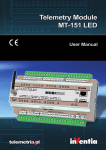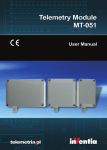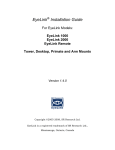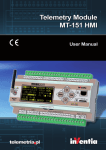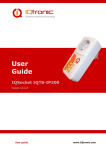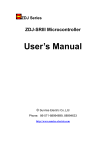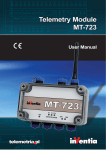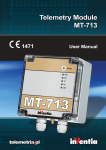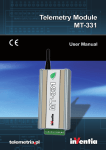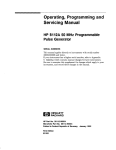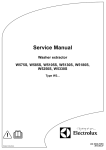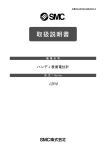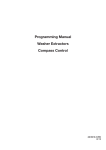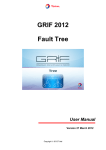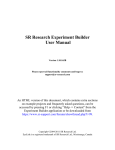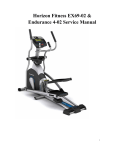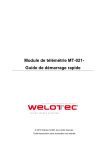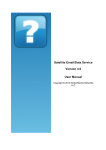Download MT-021
Transcript
Telemetry Module MT-021 User Manual GSM/GPRS Telemetry Module for monitoring and control MT-021 Class 1 Telecommunications Terminal Equipment for GSM 850/900/1800/1900 INVENTIA Sp. z o.o v1.51 MT-021 © 2013 Inventia Ltd. Wszelkie prawa zastrzeżone. Żaden fragment niniejszego dokumentu nie może być powielany lub kopiowany w żadnej formie bez względu na stosowaną technologię – graficzną, elektroniczną lub mechaniczną, włączając fotokopiowanie i/lub zapis cyfrowy, również w systemach przechowywania i wyszukiwania dokumentów – bez pisemnej zgody Wydawcy. Nazwy produktów wymienionych w niniejszym dokumencie mogą być Znakami Towarowymi i/lub zastrzeżonymi Znakami Towarowymi należącymi do odpowiednich Właścicieli. Wydawca i Autor oświadczają, że nie roszczą do tych znaków towarowych żadnych praw. Pomimo, że niniejsze opracowanie tworzone było z zachowaniem wszelkiej należytej staranności, zarówno Wydawca jak i Autor nie ponoszą żadnej odpowiedzialności za błędy lub pominięcia w jego treści jak również za straty wynikłe z wykorzystania zawartej w niniejszym opracowaniu informacji lub ewentualnie towarzyszącego jej oprogramowania. W żadnym wypadku Wydawca lub Autor nie będą odpowiedzialni za utratę zysku lub inne straty, w tym handlowe, spowodowane lub rzekomo związane, bezpośrednio lub pośrednio, z niniejszym opracowaniem. All rights reserved. No parts of this work may be reproduced in any form or by any means - graphic, electronic, or mechanical, including photocopying, recording, taping, or information storage and retrieval systems - without the written permission of the publisher. Products that are referred to in this document may be either trademarks and/or registered trademarks of the respective owners. The publisher and the author make no claim to these trademarks. While every precaution has been taken in the preparation of this document, the publisher and the author assume no responsibility for errors or omissions, or for damages resulting from the use of information contained in this document or from the use of programs and source code that may accompany it. In no event shall the publisher and the author be liable for any loss of profit or any other commercial damage caused or alleged to have been caused directly or indirectly by this document. Publisher: INVENTIA Sp. z o.o. ul. Kulczyńskiego 14 02-777 Warszawa Tel: +48 22 545-32-00 [email protected] www.inventia.pl Version: 1.51 Warsaw, Junuary 2013 MTC Compatibility: 1.51 INDEX 1. MODULE'S DESTINATION ................................................................................................................ 7 2. GSM REQUIREMENTS ...................................................................................................................... 7 3. MODULE'S DESIGN ........................................................................................................................... 7 3.1. MODULE'S TOPOGRAPHY .................................................................................................................................... 7 3.2. POWER SUPPLY ................................................................................................................................................. 8 3.3. SIM CARD ....................................................................................................................................................... 9 3.4. LED DIODES ..................................................................................................................................................... 9 3.5. ANTENNA ...................................................................................................................................................... 10 3.6. HOUSING ...................................................................................................................................................... 10 3.7. RESOURCES .................................................................................................................................................... 11 3.7.1. Binary inputs ....................................................................................................................................... 11 3.7.2. Relay outputs ...................................................................................................................................... 12 3.7.3. Analog inputs...................................................................................................................................... 12 3.7.4. Real time clock (RTC) .......................................................................................................................... 13 3.7.5. USB port .............................................................................................................................................. 13 3.7.6. Event logger ........................................................................................................................................ 14 3.7.7. Timers ................................................................................................................................................. 14 3.7.8. 1‐Wire inputs ...................................................................................................................................... 14 4. STARTING THE MODULE ............................................................................................................... 16 4.1. CONFIGURING MT‐021 USING MTMANAGER ..................................................................................................... 17 4.2. REMOTE CONFIGURATION VIA SMS .................................................................................................................... 21 4.3. HOW DO I DISABLE A SIM PIN NUMBER .............................................................................................................. 22 5. CONNECTIONS SCHEME................................................................................................................ 23 5.1. POWER SUPPLY ............................................................................................................................................... 23 5.2. BINARY INPUTS I1 ... I4 .................................................................................................................................... 24 5.3. RELAY OUTPUTS Q1...Q4 ................................................................................................................................. 25 5.4. ANALOG INPUTS AN1, AN2 ............................................................................................................................. 25 5.5. 1‐WIRE INPUTS .............................................................................................................................................. 27 6. CONFIGURATION ............................................................................................................................ 28 6.1. GENERAL INFORMATION ................................................................................................................................... 28 6.2. PARAMETER GROUPS ....................................................................................................................................... 28 6.2.1. Header ................................................................................................................................................ 29 6.2.1.1. Module name ................................................................................................................................................ 29 6.2.1.2. Module type .................................................................................................................................................. 29 6.2.1.3. Module serial number................................................................................................................................... 29 6.2.1.4. IMEI number ................................................................................................................................................. 29 6.2.1.5. SIM card number .......................................................................................................................................... 29 6.2.1.6. Modem's firmware version ........................................................................................................................... 30 6.2.1.7. Firmware version .......................................................................................................................................... 30 6.2.1.8. Configuration file version .............................................................................................................................. 30 6.2.1.9. Configuration identifier................................................................................................................................. 30 6.2.1.10. Last configuration date ............................................................................................................................... 30 6.2.1.11. Last reading time ........................................................................................................................................ 31 6.2.2. General ............................................................................................................................................... 31 6.2.2.1. SIM card PIN number .................................................................................................................................... 31 1 6.2.2.2. Configuration password ................................................................................................................................ 31 6.2.2.3. Use of GPRS .................................................................................................................................................. 32 6.2.3. SMS ..................................................................................................................................................... 32 6.2.3.1. Daily SMS limit .............................................................................................................................................. 32 6.2.3.2. Roaming for SMS .......................................................................................................................................... 32 6.2.3.3. Number of SMS sending retries .................................................................................................................... 33 6.2.3.4. Answer for blank SMS ................................................................................................................................... 33 6.2.3.5. SMS limit exceed information text ................................................................................................................ 33 6.2.3.5.1. Phone number of info recipient ............................................................................................................ 33 6.2.3.5.2. SMS limit exceed information ............................................................................................................... 34 6.2.3.6. Formats ......................................................................................................................................................... 34 6.2.3.6.1. Date format ........................................................................................................................................... 34 6.2.3.6.2. Time format .......................................................................................................................................... 34 6.2.3.6.3. General format 1 ................................................................................................................................... 35 6.2.3.6.4. General format 2 ................................................................................................................................... 35 6.2.3.7. Symbolic names ............................................................................................................................................ 35 6.2.3.7.1. Number of symbolic names .................................................................................................................. 35 6.2.3.7.2. Symbolic name ...................................................................................................................................... 36 6.2.3.7.3. Space ..................................................................................................................................................... 36 6.2.3.7.4. Register/bit number .............................................................................................................................. 36 6.2.3.8. Macros .......................................................................................................................................................... 36 6.2.3.8.1. Number of macros ................................................................................................................................ 36 6.2.3.8.2. Macro name .......................................................................................................................................... 37 6.2.3.8.3. Macro's content .................................................................................................................................... 37 6.2.4. GPRS ................................................................................................................................................... 37 6.2.4.1. APN name ..................................................................................................................................................... 37 6.2.4.2. APN user name ............................................................................................................................................. 37 6.2.4.3. APN password ............................................................................................................................................... 37 6.2.4.4. Module IP ...................................................................................................................................................... 38 6.2.4.5. GPRS login retry interval [s] .......................................................................................................................... 38 6.2.4.6. GPRS testing address (ping) .......................................................................................................................... 38 6.2.4.7. Idle time [s] ................................................................................................................................................... 38 6.2.5. Authorized numbers ........................................................................................................................... 39 6.2.5.1. Number of phone numbers .......................................................................................................................... 39 6.2.5.2. Update phone numbers from SIM card ........................................................................................................ 39 6.2.5.3. Phone number from SIM card always authorized ......................................................................................... 39 6.2.5.4. Phone ............................................................................................................................................................ 40 6.2.6. Resources ............................................................................................................................................ 40 6.2.6.1. Terminals ...................................................................................................................................................... 41 6.2.6.1.1. Inputs I1 ... I4......................................................................................................................................... 41 6.2.6.1.1.1. Name ............................................................................................................................................. 41 6.2.6.1.1.2. Input type ...................................................................................................................................... 41 6.2.6.1.1.2.1. Counter input ........................................................................................................................ 41 6.2.6.1.1.2.1.1. Counting direction ......................................................................................................... 41 6.2.6.1.1.2.1.2. Counting range (32bits) ................................................................................................. 42 6.2.6.1.1.2.1.3. Triggering slope ............................................................................................................. 42 6.2.6.1.1.3. Filtering constant [s] ...................................................................................................................... 42 6.2.6.1.2. Outputs Q1 ... Q4 .................................................................................................................................. 42 6.2.6.1.2.1. Name ............................................................................................................................................. 43 6.2.6.1.2.2. Output mode ................................................................................................................................. 43 6.2.6.1.2.3. Pulse duration [s] .......................................................................................................................... 43 6.2.6.1.2.4. On event ........................................................................................................................................ 43 6.2.6.1.2.5. Off event ....................................................................................................................................... 43 6.2.6.1.3. Analog inputs AN1...AN2 ....................................................................................................................... 44 6.2.6.1.3.1. Name ............................................................................................................................................. 44 2 6.2.6.1.3.2. Input type ...................................................................................................................................... 44 6.2.6.1.3.3. Filtering constant [s] ...................................................................................................................... 44 6.2.6.1.3.4. Signal range ................................................................................................................................... 44 6.2.6.1.3.5. Low reference ‐ internal units ....................................................................................................... 45 6.2.6.1.3.6. High reference ‐ internal units ...................................................................................................... 45 6.2.6.1.3.7. Low reference ‐ engineering units ................................................................................................. 45 6.2.6.1.3.8. High reference ‐ engineering units ................................................................................................ 45 6.2.6.1.3.9. Alarm HiHi ‐ engineering units ...................................................................................................... 46 6.2.6.1.3.10. Alarm Hi ‐ engineering units ........................................................................................................ 46 6.2.6.1.3.11. Alarm Lo ‐ engineering units ....................................................................................................... 46 6.2.6.1.3.12. Alarm LoLo ‐ engineering units .................................................................................................... 46 6.2.6.1.3.13. Alarm hysteresis ‐ engineering units ........................................................................................... 46 6.2.6.1.3.14. Deadband ‐ engineering units ..................................................................................................... 47 6.2.6.1.4. Inputs 1‐WIRE1, 1‐WIRE2 ...................................................................................................................... 47 6.2.6.1.4.1. Name ............................................................................................................................................. 47 6.2.6.1.4.2. Input type ...................................................................................................................................... 47 6.2.6.1.4.2.1. Temperature measurement .................................................................................................. 47 6.2.6.1.4.2.1.1. Alarm HiHi ...................................................................................................................... 48 6.2.6.1.4.2.1.2. Alarm Hi ......................................................................................................................... 48 6.2.6.1.4.2.1.3. Alarm Lo ......................................................................................................................... 48 6.2.6.1.4.2.1.4. Alarm LoLo ..................................................................................................................... 48 6.2.6.1.4.2.1.5. Alarm hysteresis ............................................................................................................ 48 6.2.6.1.4.2.1.6. Deadband ...................................................................................................................... 49 6.2.6.2. Synchronous timers TMR1...TMR4 ............................................................................................................... 49 6.2.6.2.1. Active .................................................................................................................................................... 49 6.2.6.2.1.1. Start [HH:MM] ............................................................................................................................... 49 6.2.6.2.1.2. Period ............................................................................................................................................ 49 6.2.6.2.1.3. Days of week ................................................................................................................................. 50 6.2.6.2.1.4. Days of month ............................................................................................................................... 50 6.2.6.3. State logging ................................................................................................................................................. 50 6.2.6.3.1. Start [HH:MM] ...................................................................................................................................... 50 6.2.6.3.2. Period .................................................................................................................................................... 50 6.2.6.3.3. Logged information ............................................................................................................................... 51 6.2.7. Events ................................................................................................................................................. 51 6.2.7.1. Number of events ......................................................................................................................................... 51 6.2.7.2. Name ............................................................................................................................................................ 51 6.2.7.3. Trigger source (binary inputs) ....................................................................................................................... 51 6.2.7.3.1. Trigger input .......................................................................................................................................... 52 6.2.7.3.2. Trigger condition ................................................................................................................................... 52 6.2.7.4. Trigger source (analog inputs) ...................................................................................................................... 52 6.2.7.4.1. Trigger input .......................................................................................................................................... 53 6.2.7.4.2. Trigger condition ................................................................................................................................... 53 6.2.7.5. Trigger source (inputs 1‐WIRE) ..................................................................................................................... 53 6.2.7.5.1. Trigger input .......................................................................................................................................... 53 6.2.7.5.2. Trigger condition ................................................................................................................................... 54 6.2.7.6. Trigger source (Clocks) .................................................................................................................................. 54 6.2.7.6.1. Triggering clock ..................................................................................................................................... 54 6.2.7.7. Trigger source (Flags) .................................................................................................................................... 55 6.2.7.7.1. Triggering flag ....................................................................................................................................... 55 6.2.7.8. Trigger source (Counters) ............................................................................................................................. 55 6.2.7.8.1. Triggering counter ................................................................................................................................. 56 6.2.7.9. Trigger source (Connections) ........................................................................................................................ 56 6.2.7.9.1. Connection from any authorized .......................................................................................................... 56 6.2.7.9.1.1. Dial‐in from number ...................................................................................................................... 57 6.2.8. Rules ................................................................................................................................................... 57 3 6.2.8.1. Massage sending ........................................................................................................................................... 57 6.2.8.1.1. Number of message sending rules ........................................................................................................ 57 6.2.8.1.2. Sender e‐mail address ........................................................................................................................... 57 6.2.8.1.3. SMTP server name ................................................................................................................................ 58 6.2.8.1.4. SMTP server port .................................................................................................................................. 58 6.2.8.1.5. SMTP authentication ............................................................................................................................. 58 6.2.8.1.6. SMTP user name ................................................................................................................................... 58 6.2.8.1.7. SMTP password ..................................................................................................................................... 58 6.2.8.1.8. Message sending rules 1...32 ................................................................................................................ 59 6.2.8.1.8.1. Triggering event ............................................................................................................................ 59 6.2.8.1.8.2. Transmission type ......................................................................................................................... 59 6.2.8.1.8.3. Recipient number .......................................................................................................................... 59 6.2.8.1.8.4. Receiver e‐mail address ................................................................................................................ 60 6.2.8.1.8.5. E‐mail title ..................................................................................................................................... 60 6.2.8.1.8.6. Message text ................................................................................................................................. 60 6.2.8.2. CLIP calls ....................................................................................................................................................... 60 6.2.8.2.1. Number of CLIP calls rules ..................................................................................................................... 61 6.2.8.2.2. CLIP call rules 1...16 ............................................................................................................................... 61 6.2.8.2.2.1. Triggering event ............................................................................................................................ 61 6.2.8.2.2.2. Recipient number .......................................................................................................................... 61 6.2.8.3. E‐mail sending ............................................................................................................................................... 61 6.2.8.3.1. Number of e‐mail sending rules ............................................................................................................ 61 6.2.8.3.2. Sender e‐mail address ........................................................................................................................... 62 6.2.8.3.3. SMTP server name ................................................................................................................................ 62 6.2.8.3.4. SMTP server port .................................................................................................................................. 62 6.2.8.3.5. SMTP authentication ............................................................................................................................. 62 6.2.8.3.6. SMTP user name ................................................................................................................................... 63 6.2.8.3.7. SMTP password ..................................................................................................................................... 63 6.2.8.3.8. E‐mail sending rules 1...16 .................................................................................................................... 63 6.2.8.3.8.1. Triggering event ............................................................................................................................ 63 6.2.8.3.8.2. Receiver e‐mail address ................................................................................................................ 63 6.2.8.3.8.3. E‐mail title ..................................................................................................................................... 64 6.2.8.3.8.4. E‐mail text ..................................................................................................................................... 64 6.3. CONFIGURATION WRITING ................................................................................................................................ 64 6.4. VERIFICATION OF CONFIGURATION ..................................................................................................................... 64 7. TECHNICAL DATA ........................................................................................................................... 65 7.1. GENERAL ....................................................................................................................................................... 65 7.2. GSM MODEM ............................................................................................................................................... 65 7.3. POWER SUPPLY ............................................................................................................................................... 65 7.4. BINARY INPUTS I1....I4 .................................................................................................................................... 66 7.5. RELAY OUTPUTS Q1...Q4 ................................................................................................................................. 66 7.6. ANALOGUE INPUTS AN1, AN2 .......................................................................................................................... 66 7.7. DRAWINGS AND DIMENSIONS (ALL DIMENSIONS IN MILLIMETERS) ............................................................................ 67 8. PROBLEM SOLVING ....................................................................................................................... 68 8.1. LED SIGNALING .............................................................................................................................................. 68 8.2. UNBLOCKING OF SIM CARD .............................................................................................................................. 69 9. SAFETY INFORMATION .................................................................................................................. 69 9.1. WORKING ENVIRONMENT ................................................................................................................................. 69 9.2. ELECTRONIC EQUIPMENT .................................................................................................................................. 69 9.2.1. Heart pacemakers .............................................................................................................................. 69 4 9.2.2. Hearing aids........................................................................................................................................ 69 9.2.3. Other medical equipment ................................................................................................................... 69 9.2.4. RF Marked equipment ........................................................................................................................ 70 9.3. EXPLOSIVE ENVIRONMENT ................................................................................................................................ 70 10. APPENDICES ................................................................................................................................. 70 10.1. REGISTER OF CHANGES ................................................................................................................................... 70 10.2. MODULE CONFIGURATION VIA SMS ................................................................................................................. 71 10.3. SYNTAX FOR READING AND WRITING DATA IN SMS MODE ..................................................................................... 79 10.4. MEMORY MAP ............................................................................................................................................. 85 10.4.1. Analog inputs address space ............................................................................................................ 86 10.4.2. Internal registers address space ....................................................................................................... 90 10.5. FLAGS ......................................................................................................................................................... 91 5 6 1. Module's destination Telemetry Module MT-021 with built-in GSM modem is a device dedicated for remote monitoring, diagnostics and control of objects via short text messages (SMS), CLIP calls or e-mail. Configurable messages send from device with static (text) or dynamic (text and measured values) content are a convenient way of passing important information to the monitoring center, or directly to the defined phone numbers. SMS messages sending can be triggered by change of binary input state, reaching alarm thresholds, marker state change, counters and clocks. Industrial design, practical set of I/O resources, easy to use software tools as well as the ability to configure the module from remote via SMS commands are significant advantages of MT-021 in the wireless telemetry systems. Direct connection of temperature sensors lowers the cost of building system. 1-Wire inputs can be used for reading typical Dallas pellets for the purpose of identification and authentication. The module can work with humidity sensors, water level sensor, pressure transducers, flow sensors, smoke, gas, motion, shock and noise detectors, etc. Typical applications: • Alarm systems • Access control • Preventive diagnostic • Remote meter reading (AMR) • Remote control of various devices by CLIP call or SMS (gates, pumps, heating, lighting, etc.) 2. GSM requirements For proper operation of the module a SIM card provided by a GSM operator with SMS/CLIP option enabled is essential. Enabled GPRS communication allows device to send e-mails. A paramount condition for operation is securing the adequate GSM signal level in the place where module's antenna is placed. Using the module in places where there is no adequate signal level may cause breaks in transmission and thereby data loss along with generating excessive transmission costs. 3. Module's design 3.1. Module's topography 7 3.2. Power supply MT-021 may be powered by 9...30 V (DC). 8 NOTICE! Exceeding the range of accepted power supply voltage may cause faulty operation or damage to the module! 3.3. SIM card MT-021 telemetry module is equipped with standard miniature SIM card holder for connecting card to GSM modem. Proper placement of the SIM card is imperative for module's operation. The module accepts only SIM cards operating in low potential technology 3,3V. 3.4. LED diodes LED indicators placed on MT-021 front panel are convenient during module start up phase. The LED's have assigned following significance: PWR LED indicates module's activity, I1 ... I4 LED indicates state of binary inputs, Q1 ... Q4 LED indicates state of binary outputs, ERR LED indicates an error, GSM LED reflects current login to GSM network state, SGN LED reflects GSM signal strength, ACT (Tx i Rx) LEDs indicate GSM communication (TX - data transmission, RX - data reception), USB LED indicates USB port state. Detailed description can be found in LED signaling subchapter of Problem solving chapter. 9 3.5. Antenna Attachment of antenna is essential for proper operation of MT-101 telemetry module. SMA socket is placed on module's front panel. The attached antenna has to secure appropriate radio signal level enabling login to GSM network. The type and placement of antenna has significant influence on module's sender/receiver circuits. GSM signal level is reflected by SGN led on module's front panel. Please use a directional antenna system when GSM signal level is not sufficient. Refer chapter Problem solving/LED signaling. 3.6. Housing MT-021 module is encapsulated in standard housing made of plastic compliant with safety requirements and protecting the module in standard operating environment. The applied solution complies with standard industrial requirements for DIN rail mounting. 10 3.7. Resources MT-021 module's resources: I1...I4 - binary inputs Q1...Q4 - Relay outputs CNT - Counters 4 Optoisolated binary inputs 4 Relay outputs can operate in one of two functional modes: monostable bistable 0 (max. 4) Each input can work as a counter input AN1, AN2 - Analog inputs 2 PT100 NTC 0..10V/0..5V 4-20mA 1-Wire - Inputs 2 Standard Dallas I-Button, Temperature measurement USB Port 1 Standard RS232 - configuration 3.7.1. Binary inputs MT-021 module is equipped with 4 optoisolated binary inputs marked as I1...I4. They may work only in positive logic. All binary inputs have same reference - module's electrical ground - negative pole of the power supply connected to GND pin. The change of the input signal sets the alarm flag, connected with the corresponding binary input respectively as Bi 0->1, Bi 1->0 or Bi 0->1|Bi 1->0. 11 Any of binary inputs I1...I4 may operate as counter input. This requires a change in the operating mode of input, which is made during its configuration. The counter can count „up” or „down”, and the range can be freely defined in range of 1 to 2 147 483 647. Counting "up" means that the counter value is increased by 1 for each detected pulse and after reaching the value set as "counter length-1" is reset to "0". Counting "down" diminishes the counter value by 1 for each detected pulse and after reaching the value set as "counter length-1" is reset to "0" to resume the value of defined maximum. Crossing the value of counter length sets counter flag for respective input. These flags may be used in events table to trigger rules. 3.7.2. Relay outputs MT-021 telemetry module has 4 relay outputs Q1 ... Q4. Outputs can operate in one of two functional modes: monostable bistable The outputs operate independently and are isolated from each other. Outputs are control by writing value to the internal register (No. 8 - OUT_CTRL flag). This can be made remotely via SMS or CLIP. 3.7.3. Analog inputs MT-021 provides two analog inputs marked as AN1, AN2 which can operate in following modes: AN1: PT100 sensor temperature readout voltage input - 0…5V/0…10V current input - 4…20mA 12 AN1: NTC sensor temperature readout voltage input - 0…5V/0…10V current input - 4…20mA 3.7.4. Real time clock (RTC) MT-021 Module is equipped with astronomical time clock (RTC). The clock is a base for defining working cycles of module, timers and time stamps for measurement results recorded in registers. Imprecise clock setting results in faulty time stamping and subsequent loss of vital information. For that reason, it is recommended to set the clock to UTC time instead of the local time zone of the module's placement. CAUTION! The clock setting has to be repeated if the module was turned off for long time. Setting the time is described in configuring mode documentation for the MTManager program. There is also a method for setting the RTC remotely using SMS configuration commands described in chapter Starting the module/Remote configuration via SMS. 3.7.5. USB port MT-021 module is equipped with one USB port. This port is intended for the local configuration of the module's parameters and readout event logger. The port should be connected to an external PC computer with the configuration program running (MTManager) or software for reading event logger (MT Log Reader). 13 3.7.6. Event logger MT-021 automatically registers events like analog inputs measurement, time interval being counted by timer, GSM logon, making an outgoing call, one of analog values exceeding an alarm thresholds value, module power on and other. Logger can store up to 48000 records. This allows to reconstruct the history of module operations. Logger records can be read via USB using MT Log Reader application. 3.7.7. Timers MT-021 provides four synchronous timers TMR1…TMR4 that enable cyclical time measuring from 1 min to 1 month with synchronization with module z RTC clock. Timers can be used for triggering various actions like establishing clip calls, setting binary outputs and other. 3.7.8. 1-Wire inputs Telemetry Module MT-021 is equipped with two 1-Wire inputs for connection sensors using this interface for transmission of measured temperature value and Dallas I-button used for identification. There is possibility of creating individual 1-Wire solutions to suit special application needs. For more information please contact your local distributor. 14 15 4. Starting the module Starting MT-021 module requires few basic activities. There are two methods of configuring module: locally - using MTManager remotely - via SMS Using one method does not exclude using of the second as the can be used interchangeably. Starting MT-021 1. Connect GSM antenna, 2. Install SIM card. If plan to make first configuration of module via SMS turn off PIN code request, Notice! The details of the procedure unlock the SIM card is described in the chapter How do I disable a SIM PIN number. 3. Connect power to module ('POWER' terminal block; 9...30 VDC). Correct power connection is signaled by PWR LED (green light). After connecting power the module starts process of registration in the GSM network. If you use a SIM card with PIN code request option turned off, module should log on to the GSM network. Successful GSM network logon is indicated by three blinks of GSM LED and signal strength presented on SGN LEDs. 16 In next steps you will see how to create basic configuration, which can be described by following points: Entering PIN code, Adding telephone number to authorized phone list, Defining event for binary input I1 when it is changing its state from 0 to 1 (rising edge), Defining SMS sending rule which will send SMS that reads “ALARM” to a predefined phone number when previously configured event is triggered, Setting RTC clock of the device. 4.1. Configuring MT-021 using MTManager Install MTManager on your PC from CD provided with module. When installed with default setting MTManager creates shortcuts on Desktop and in Start menu. Please proceed to next step. Start MTManager by double-click on shortcut icon: In newly created MTManager project add new module using main menu option General->New->Module. 17 Choose MT-021 as type, type module name (e.g. ST_1) in name field and select firmware version (firmware version is marked on the box). In the next step set parameters essential for establishing GSM connection: SIM card PIN number (required if PIN code request is on Configuration password to protect module from unauthorized access. Open Authorized numbers -> Phone and add to the list new telephone number which will be receiving SMS messages from device (e.g. +48111222333). 18 Create Event EVT1 (in this example event will be triggered by binary input I1 when changing it will change logical state 0->1). As last step of configuration please set SMS sending rule 1. Choose EVT1 as Triggering event, type ALARM in SMS text. NUM1 corresponds to telephone number added in previous step. 19 To write into module configuration prepared in previous steps connect MT-021 with PC using USB cable provided with module. Proper USB connection is signaled by USB LED. Operating system should automatically install driver for MT-021 - it will be seen in Device Manager as additional COM port called Silicon Labs CP210x USB to UART Bridge (COMX), where X is COM port number. Please open Environment in MTManager (General->Environment), set correct COM port in USB cable option and press Write to save setting. 20 Next press Connect (Transmission->Write). button (Transmission->Connect) then Write button At the end synchronize device RT using Set time button (Configuration->Set time). Now setting binary input in high logical state, e.g. by connecting V+ cable with terminal I1 and power GND with binary inputs GND, will result in sending SMS that reads ‘ALARM ‘ to +48111222333. 4.2. Remote configuration via SMS Configuration described in chapter Configurating MT-021 using MTManager can be also written to module using SMS commands. Those commands, their default values and allowed value ranges are described in chapter Appendices/Module configuration via SMS. Below you can find sample configuration SMS: 21 &#SPIN="2323"#CONF_PSW="PASS"#SMSN_1="+48111222333"#EVNO=1 #EV_TRIG_1=2#EV_FLAG_1=0#EV_EDGE_1=1#TRNO=1#TR_TRIG_1=1 #TR_TCH_1=1#TR_T_1="ALARM"#TR_N_1=1 That SMS sets: SIM card PIN number (2323) Configuration password (PASS) First telephone on Authorized->Phone list (+48111222333) Event EVT1 triggered when binary input I1 changes its logical state 0->1 SMS sending rule 1 which will send SMS saying ALARM to previously defined telephone number each time event EVT1 is triggered. As an answer to this SMS module will send back the same text preceding it with '>' sign. After first configuration it is good to adjust module RTC. SMS below sets time to last second of 2010: &PASS#CRTC="2010-12-31 23:59:59" SMS begins new password set by previous configuration SMS preceded by '&' sign. First configuration can be done from any phone number. Any following SMS configuration commands will be accepted only from numbers placed on Authorized list. Therefore it is vital to enter at least one phone number to that list during first configuration. Maximum length of SMS configuration command should not exceed 160 signs. Now setting binary input in high logical state, e.g. by connecting V+ cable with terminal I1 and power GND with binary inputs GND, will result in sending SMS that reads ‘ALARM ‘ to +48111222333. 4.3. How do I disable a SIM PIN number The procedure for setting the SIM mode to allow its use without requiring a PIN (e.g. Nokia, model 6210): Place the SIM card into the appropriate slot on the phone. Turn on the phone, and enter the correct PIN number for your SIM card. From the available commands, select Menu\Settings\Security Settings. Choose menu PIN code request then press Select, you will be prompted for a PIN number. Then select OFF response to a question PIN code request At the end appears a message PIN code request is not active. 22 5. Connections scheme The chapter shows standard configurations securing proper operation of MT-021 module's integral inputs/outputs in all available operating modes. 5.1. Power supply MT-021 module can be powered from any DC power source providing voltage within the range 9-30 VDC. Notice! Exceeding the range of power supply may cause faulty operation or damage the module! Notice! Supply cables length < 10m. Signal cables length < 30m. For longer cables it is recommended to use external overvoltage protection. 23 5.2. Binary inputs I1 ... I4 Internal optoisolated binary inputs marked as I1...I4 may work only in positive logic. All binary inputs have same reference - module's electrical ground - negative pole of the power supply connected to GND pin. Connection scheme: Notice! Supply cables length < 10m. Signal cables length < 30m. For longer cables it is recommended to use external overvoltage protection. 24 5.3. Relay outputs Q1...Q4 Telemetry module has 4 normally open (NO) relay outputs marked as Q1 ... Q4. The outputs operate independently and are isolated from each other. Connection scheme: Notice! Maximum voltage between contacts is 230V AC Maximum switching current is 6A. 5.4. Analog inputs AN1, AN2 Analog inputs AN1 and AN2 can be used for measuring temperature using Pt-100 and NTC sensors or collecting measurements via current (4-20mA) or voltage signal (0-5V/0-10V). Mode of operation is user-configurable. Below are shown proper connection schematics: 25 Pt-100 - 2 wire (AN1 only) Pt-100 - 3 wire (AN1 only) NTC (AN2 only) Voltage output sensor 26 Current output sensor 5.5. 1-Wire inputs For the 1-Wire communication is used one line for data and GND line. The MT-021 has two 1-Wire bus inputs marked as 1 and 2 with a common reference point (GND). Connection scheme: 27 6. Configuration 6.1. General information The configuration of MT-021 module, as is the case for other modules in the MT series, is carried out using the MTM (MT Manager) program portal, delivered free of charge to users of our telemetry solutions. The portal is a specialized environment providing full control of the entire telemetry system regardless of the system's size. The possibility of dividing hardware resources into Projects and Folders facilitates efficient management of very complex telemetry systems. After adding a new module to the environment and selecting it, all module parameters are available for editing. Detailed description of functions and their applications are to be found in MTM user manual. Each of the configuration parameters is also possible to set by SMS. SMS schemes have been presented in Chapter Appendices/Module configuration via SMS NOTICE! Availability of different functions and parameters depends on module's firmware version and the settings of parameters they may be dependent on. 6.2. Parameter groups For clarity and ease of use, the operating parameters of MT-021 module are divided into logically or functionally connected groups in the following order: Header group - contains unmodifiable parameters describing the module, its firmware and configuration. General group - contains basic parameters defining module's operating mode SMS group - contains parameters for SMS services handling GPRS group - contains parameters for GPRS logging Authorized numbers group - contains lists of phone numbers of other terminals authorized for communication with configured module. Resources group - defines parameters for hardware and software resources related to reading and processing measurement data. Events group - contains list of defined events (e.g. binary input state change), used to trigger module's actions (e.g.: sending SMS or trigger CLIP) Rules group - contains lists of transmission tasks to be carried out upon occurrence of activating criteria 28 6.2.1. Header Header of parameter structure describes MT-021 telemetry module. It holds basic information unique to the module, the configuration contained by module and configuration file version. Information displayed is not user editable and solely used for verification and information purpose. 6.2.1.1. Module name Function - displays name assigned to module during configuration Data type - text Range - n/a, read-only parameter Default value - New module Comments - n/a 6.2.1.2. Module type Function - displays the type of configured telemetry module Data type - text Range - n/a, read-only parameter Default value - MT-021 Comments - n/a 6.2.1.3. Module serial number Function - displays serial number configured telemetry module Data type - text Range - n/a, Read-only parameter Default value - n/a Comments - this field displays module serial number assigned during manufacturing. This number is static and unique identifier of the unit. 6.2.1.4. IMEI number Function - displays GSM modem's IMEI number Data type - text Range - n/a, read-only parameter Comments - n/a 6.2.1.5. SIM card number Function - displays SIM card's serial number Data type - Number Range - n/a, read-only parameter Comments - n/a 29 6.2.1.6. Modem's firmware version Function - displays GSM modem's firmware version Data type - text Range - n/a, read-only parameter Default value - n/a Comments - the field updates automatically after downloading the firmware. 6.2.1.7. Firmware version Function - displays the identifier of current firmware version Data type - text Range - n/a, read-only parameter Default value - e.g. 1.00 Comments - the field updates automatically after downloading the firmware. 6.2.1.8. Configuration file version Function - displays version identification of configuration file used for actual configuration Data type - text Range - n/a, Read-only parameter Default value - e.g. 1.00 C Comments - value depends on module's firmware version chosen during creation of module definition. Auxiliary extension character defines the sub-version 6.2.1.9. Configuration identifier Function - displays identification of current configuration Data type - hexadecimal Range - n/a, read-only parameter Comments - the value of this parameter increases automatically by 1 after each successfully stored configuration. 6.2.1.10. Last configuration date 30 Function - displays time and date of last successful configuration change Data type - text Range - n/a, read-only parameter Comments - the value changes automatically with successful configuration change. Useful in tracing unauthorized configuration changes. 6.2.1.11. Last reading time Function - displays internal module time recorded during last configuration reading or during last time setting Data type - text Range - compliant with Date and Time format Comments - this field is useful in verifying last access time and checking internal module clock settings (RTC) 6.2.2. General General group encompasses parameters vital for whole module. Contains data necessary for successful login to GSM network and password-protection module configuration. Note: values set here have impact on module's behavior and in worst case, when chosen improperly may even lock the module. 6.2.2.1. SIM card PIN number Function - defines PIN access code for SIM module delivered by GSM operator. For SIM modules not protected by PIN code, the value is insignificant. Data type - Number Range - numerals, from 4 to 8 characters Default value - empty Comments - wrong pin can cause locking of SIM module CAUTION! Caution is vital when setting the PIN code value. Entering faulty PIN code may cause module start-up to be impossible and lock SIM card. In latest versions of the module, attempting to enter wrong PIN code twice renders a third attempt impossible. Procedure in case of blocked module as the result of the wrong PIN value 6.2.2.2. Configuration password Function - defines the password protecting access to configuration of the module. The password will be required for both local and remote access, thus protecting against unauthorized configuration alterations. The password does not protect against reading current configuration or the module status. Data type - text string Range - letters and numerals, max. 32 characters Default value - n/a Comments - since the only way of unlocking the module is resetting it to factory settings, it is vital that the password is stored in a safe way and available when needed. 31 6.2.2.3. Use of GPRS Function - enables GPRS usage required for e-mail sending. Data type - Selection list Range - No Yes GPRS is disabled. GPRS is enabled. Default value - No Comments - When GPRS is enabled new group of parameters called GPRS is visible. 6.2.3. SMS Group SMS contains parameters related to sending and receiving of text messages by MT-021 module. 6.2.3.1. Daily SMS limit Function - Defines max number of SMS, the module may send during one day. The parameter protects against uncontrolled sending of SMS messages and consequent high running expenses. Data type - Number Range - 1…65 535 Default value - 0 = unlimited Comments - N/A ATTENTION! Reaching set by the parameter limit results with unconditional stop of SMS sending. One has to bear in mind that until 00:00 o'clock no messages will be sent even in alarm situations! Unsent due to limitation SMS messages are queued (the queue holds 16 messages) and will be sent when it is possible (after 00:00). If the number of queued messages is higher than the limit set by the user, there is a risk of immediate consuming of the next day limit. 6.2.3.2. Roaming for SMS Function - Decides whether the module may send SMS when roaming in foreign network. Data type - Selection list Range - No Answer 32 When roaming in foreign GSM network no SMS are sent. The module can only respond to queries from authorized numbers Yes All SMS messages are sent regardless of the GSM roaming Default value - Answer Comments - In order to be able to sent SMS in roaming the SIM card in the module has to have roaming option active. 6.2.3.3. Number of SMS sending retries Function - Defines max number of retries of failed SMS transmission Data type - Number Range - 0…255 Default value - 10 Comments - After reaching the defined value the SMS is deleted from sending queue. 6.2.3.4. Answer for blank SMS Function - defines the text of reply for empty SMS to the sender. Data type - Text Range - max. 160 characters Default value - *M0 Comments - In replay message text symbolic names may be used following syntax rules defined in Appendices in the Syntax of read and write commands in SMS chapter. 6.2.3.5. SMS limit exceed information text Function - Decides whether the module may send alert that SMS limit was exceeded. Data type - Selection list Range - On Off module send SMS limit alert to defined phone number of info recipient disabled sending SMS limit alert Default value - Off Comments - This information is sent beyond standard messages queue and only once a day. This message does not increment sent messages counter. 6.2.3.5.1. Phone number of info recipient Function - Selects the SMS limit alert recipient Data type - Selection list Range - Authorized numbers list Default value - NUM 1 33 Comments - The recipient must be previously defined in Authorized numbers -> Phone. 6.2.3.5.2. SMS limit exceed information Function - Contains the text of the SMS message sent upon reaching Daily SMS limit. Data type - Text Range - max 160 characters Default value - empty Comments - This information is sent beyond standard messages queue and only once a day. This message does not increment sent messages counter. 6.2.3.6. Formats Group Formats contains parameters allowing user to define formats of date and time presented in SMS messages. 6.2.3.6.1. Date format Function - Defines date format used by #date predefined symbolic name and by ld and ud macro prefixes Data type - Text Range - 0...31 signs Default value - YYYY-DD-MM Comments - In the text user can put any sign combination but predefined with special meaning listed below: YYYY - if placed in this format text automatically changed for year in four digit notation (e.g. 2011), YY - if placed in this format text automatically changed for year in two digit notation (e.g. 11), MM - if placed in this format text automatically changed for month (e.g. 01 for January), DD - if placed in this format text automatically changed for day of month (e.g. 31). Example: Parameter is set to: Date of measurement: YYYY-MM-DD Macro result is (providing today is 31st of January 2011): Date of measurement: 2011-01-31 Function - Defines date format used by #time predefined symbolic name and by lt and ut macro prefixes Data type - Text 6.2.3.6.2. Time format 34 Range - 0...31 signs Default value - HH:MN:SS Comments - In the text user can put any sign combination but predefined with special meaning listed below: HH - if placed in this format text automatically changed for current hour in 24h format (e.g. 01), MN - if placed in this format text automatically changed for current minutes (e.g. 01), SS - if placed in this format text automatically changed for current seconds (e.g. 59). Example: Parameter is set to: Time of measurement: HH:MN:SS Macro result is (providing the time is 01:01:59): Time of measurement: 01:01:59 6.2.3.6.3. General format 1 Function - Defines date format used by #RTC predefined symbolic name and by T1 macro prefix Data type - Text Range - 0...31 signs Default value - YYYY/MM/DD, HH:MN:SS Comments - In the text user can use symbols available for parameters Date format i Time format. 6.2.3.6.4. General format 2 Function - Defines date format used by T2 macro prefix Data type - Text Range - 0...31 signs Default value - YYYY/MM/DD, HH:MN:SS Comments - In the text user can use symbols available for parameters Date format i Time format. 6.2.3.7. Symbolic names Symbolic names group contains names assigned by the user referring to the internal and input registers. There can be defined up to 16 symbolic names. In order to use a symbolic name in SMS put it name preceded by '#' sign in SMS text send from mobile phone or defined in Rules/SMS sending or as a component of user-defined macros. Using symbolic names makes composing SMS text much more convenient and user friendly. 6.2.3.7.1. Number of symbolic names Function - declares number of user defined symbolic names. Data type - number Range - 1..16 Default value - 1 Comments - N/A 35 6.2.3.7.2. Symbolic name Function - Defines user friendly name Data type - Text Range - 0..50 characters Default value - IREG0...IREG15 Comments - N/A Function - Selection of register address space assigned to symbolic name. Data type - selection list Range - HReg 6.2.3.7.3. Space IReg HB IB Internal registers address space (registers readout) Analog input address space (registers readout) Internal register address space (bits readout) Analog register address space (bits readout) Default value - IReg Comments - N/A 6.2.3.7.4. Register/bit number Function - This parameter, together with the parameter Space defines the register address or bit assigned to symbolic name. Data type - number Range - 0...65535 Default value - 0...15 Comments - N/A 6.2.3.8. Macros Macros group contains up to 16 use-defined macros. Macro may contain ASCII signs, symbolic names, SMS commands and other macros that will be put in SMS text. In order to use a symbolic name in SMS put it name preceded by '*' sign in SMS text send from mobile phone or defined in Rules/SMS sending or other macro. Using macros makes composing complex SMS texts and queries much more convenient and user friendly. 6.2.3.8.1. Number of macros 36 Function - declares number of user defined macros. Data type - number Range - 1..16 Default value - 1 Comments - N/A Function - Defines macro's user friendly name Data type - Text Range - 0..20 characters Default value - M0 Comments - N/A Function - The content that is inserted into the SMS message, instead of macro name. Data type - text Range - 0..160 characters Default value - #lt.ir0 #ld.ir0 Comments - N/A 6.2.3.8.2. Macro name 6.2.3.8.3. Macro's content 6.2.4. GPRS GPRS group contains parameters related to GPRS transmission an logging. 6.2.4.1. APN name Function - defines APN name selected for GPRS transmission Data type - text Range - letters, numerals, special characters Default value - empty Comments - absence of APN name disables login to GPRS network - max. 63 characters 6.2.4.2. APN user name Function - defines APN user name Data type - text Range - letters, numerals, special characters - max. 31 characters Default value - empty Comments - Optional parameter used only if required by GSM network operator 6.2.4.3. APN password Function - defines password for APN user account Data type - text Range - letters, numerals, special characters - max. 31 characters 37 Default value - empty Comments - Optional parameter used only if required by GSM network operator 6.2.4.4. Module IP Function - allows user to define IP number for newly created module definition and displays IP number read from the module configuration that was assigned to the module during last login to GPRS network Data type - IP number field Range - 0.0.0.0 - 255.255.255.255 Default value - 0.0.0.0 Comments - If after reading the configuration or setting device time this parameter value is different from 0.0.0.0, it means that module is logged into GPRS network with this particular IP address assigned to it. 6.2.4.5. GPRS login retry interval [s] Function - Defines interval (in seconds) between retries of GPRS logon attempts after GPRS login failure. Data type - number Range - 10...3600 [s] Default value - 10 [s] Comments - 6.2.4.6. GPRS testing address (ping) Function - sets IP address which is used to test GPRS network connection in case it is lost Data type - IP address field Range - 0.0.0.0 - 255.255.255.255 Default value - 0.0.0.0 Comments - This parameter sets recipient address for ping data frames testing GPRS transmission channel. Leaving recipient address at 0.0.0.0 turns off GPRS testing functionality which is not advised. 6.2.4.7. Idle time [s] 38 Function - Defines interval (in seconds) for sending data frame (ping) testing GPRS network in case it is lost Data type - number Range - 0...21600 [s] (6h) Default value - 0 [s] Comments - in case of inactivity longer than the value defined in this parameter the module sends a control frame in order to check whether transmission is still possible. The frame is sent to the address specified by parameter GPRS testing IP address, if different than 0.0.0.0. Lack of reply to sent ping frame after exercising defined timeout and number of retries is considered as GPRS connection loss and resets modem. 6.2.5. Authorized numbers Group Authorized numbers comprises lists of phone numbers the module is going to communicate with. 6.2.5.1. Number of phone numbers Function - Defines the length of phone numbers list authorized to exchange SMS messages. Data type - Number Range - 1…32 Default value - 1 Comments - The value of this parameter may vary as the result of adding/deleting when using the context menu operating directly on Phone number. The module will communicate only with units with the phone number present on the list. Read more in Syntax for reading and writing data in SMS mode chapter of Appendices. 6.2.5.2. Update phone numbers from SIM card Function - Enables synchronization of Authorized numbers\Phone list with phone book saved on Defines the length of phone numbers list authorized to exchange SMS messages. Data type - selection list Range - Yes No synchronization is on synchronization is off Default value - No Comments - Synchronization is done after every reboot of the module, after inserting the SIM card or when configuration is written to the module. The module browses SIM card phone book and if it finds entries of the same name as defined in the Authorized numbers\Phone it overrides the numbers from configuration with the numbers from the SIM card. Those numbers are remembered till module restart. 6.2.5.3. Phone number from SIM card always authorized Function - Enables receiving voice calls authorization for all phone numbers stored in SIM card phone book. 39 Data type - selection list Range - Yes No authorization is on authorization is off Default value - No Comments - If set to Yes, all mobile phones stored on SIM card are treated as if they were placed on Authorized numbers\Phone list with tick next to Receiving voice calls option. The name assigned to him on the SIM card cannot be empty. Phone book entries with empty name won't be analysed. lp. - Index number Name - Friendly name facilitating identification of the module while defining Rules. Max. length 16 characters Number - Phone number assigned to list index. Max. 14 characters Configuration - Depending on configuration settings incoming configuration SMS will be processed or ignored. Default value: (Allowed) Query - The module receives and analyzes SMS query messages depending on selected setting. When Query is not allowed, all SMS query messages from that phone number will be ignored Default value: (not allowed) Receiving voice calls - The module receives calls and can use these signals for trigger event depending on selected setting. When Receiving is not allowed, all calls from that phone number will be ignored Default value: (not allowed) 6.2.5.4. Phone Entries on phone list may be easily added and deleted by using context menu activated by right mouse button click on any position of the list in parameters window. 6.2.6. Resources Resources group contains user defined hardware configuration. Particular sub-groups contain fields allowing fast and intuitive preparation of the module to perform measurements and evaluations of external parameters (binary states, counters, temperature and air humidity) as well as internal (timers, flags). 40 6.2.6.1. Terminals Sub-group Terminals gathers all inputs and outputs. Depending on type of accepted input, they are binary and analogue. Final functionality of each input depends on settings and configuration parameters connected. 6.2.6.1.1. Inputs I1 ... I4 Module MT-021 has four identical binary inputs. Inputs can operate in one of two functional modes: standard binary input counter input Each mode has a set of specific configuration parameters. 6.2.6.1.1.1. Name Function - Defines input's user friendly name Data type - Text Range - Letters and numerals, max. 16 characters Default value - Respective I1, I2, I3, I4 Comments - Assigning friendly names facilitates discrimination of inputs destination and required settings. 6.2.6.1.1.2. Input type Function - Defines binary input's operating mode. Data type - Selection list Range - Binary input Operates as binary input Counter input Operates as counter input Default value - Binary input Comments - According to selected mode MTManager displays additional configuration parameters for each input 6.2.6.1.1.2.1. Counter input 6.2.6.1.1.2.1.1. Counting direction Function - defines counting direction Data type - selection list Range - Up A pulse on input increases value of counter register Down A pulse on input decreases value of counter register Default value - Up Comments - N/A 41 6.2.6.1.1.2.1.2. Counting range (32bits) Function - defines max. value assumed by the counter Data type - number Range - 0....2 147 483 647 Default value - 0 Comments - N/A 6.2.6.1.1.2.1.3. Triggering slope Function - selects counting direction Data type - selection list Range - Bi 0->1 The change of counter state occurs upon signal change from 0 > 1 Bi 1->0 The change of counter state occurs upon signal change from 1 > 0 Bi 0->1 | 1->0 The change of counter state occurs upon any change of signal Default value - Bi 0->1 Comments - N/A 6.2.6.1.1.3. Filtering constant [s] Function - Defines (in seconds) value of minimum duration of altered state on input in order to consider state to be stable. Data type - number Range - 0....163,83 [s] Default value - 0,10 [s] Comments - Setting value appropriate to contact characteristics eliminates disturbance caused by contact bounce thus preventing multiple registration of what is in reality one pulse. 6.2.6.1.2. Outputs Q1 ... Q4 The MT-021 module is equipped in four relay outputs Q1...Q4. Outputs can operate in one of two functional modes: monostable bistable Each mode has a set of specific configuration parameters. 42 6.2.6.1.2.1. Name Function - Defines output's user friendly name Data type - Text Range - Letters and numerals, max 16 characters Default value - Respectively (Q1...Q4) Comments - Assigning friendly names facilitates discrimination of outputs destination and required settings. Function - selection of binary output mode Data type - selection list Range - Monostable binary output is set for time given by Pulse duration parameter Bistable state of output is defined by user Default value - Monostable Comments - N/A 6.2.6.1.2.2. Output mode 6.2.6.1.2.3. Pulse duration [s] Function - defines length (in seconds) of impulse on binary output in monostable output mode Data type - number Range - 0.1 ... 214748364.7 Default value - 0.1 Comments - N/A Function - Allows selection of predefined event from the event list, which is to be used to turn on output. Data type - selection list Range - None or names of event from the Events table 6.2.6.1.2.4. On event Default value - None Comments - N/A Function - Allows selection of predefined event from the event list, which is to be used to turn off output. Data type - selection list Range - None or names of event from the Events table Default value - None Comments - Parameter is only available when Output mode is set to Bistable. 6.2.6.1.2.5. Off event 43 6.2.6.1.3. Analog inputs AN1...AN2 MT-021 module is equipped with two analog inputs operating in 4...20mA or 0...5V/0...10V standard and direct measurement of the temperature sensor PT100 (AN1) or NTC (AN2). Each mode has a set of specific configuration parameters. 6.2.6.1.3.1. Name Function - Defines input's user friendly name Data type - Text Range - Letters and numerals, max. 16 characters Default value - Respectively (AN1, AN2) Comments - Assigning friendly names facilitates discrimination of inputs destination and required settings. 6.2.6.1.3.2. Input type Function - selection of analog input mode Data type - selection list Range - Voltage input signal measurement 0..10V or 0..5V depending on selected setting Current input signal measurement 4..20mA Pt100 temperature measurement by PT100 sensor (available for AN1) NTC temperature measurement by NTC sensor (available for AN2) Default value - Voltage input Comments - N/A 6.2.6.1.3.3. Filtering constant [s] Function - defines (in seconds) the value of the measurement averaging time of analog input Data type - selection list Range - 0, 0.05, 0.1, 0.25, 0.5, 1, 2, 4, 8 Default value - 0 Comments - N/A 6.2.6.1.3.4. Signal range 44 Function - selection of voltage analog input range Data type - selection list Range - 0...10V or 0...5V Default value - 0...10V Comments - N/A 6.2.6.1.3.5. Low reference - internal units Function - used along with other reference parameters for rescaling input signal range to engineering units range Data type - number Range - 0...500 for voltage input (range 0...5V) 0...1 000 for voltage input (range 0...10V) 0...2 000 for current input Default value - 0 for voltage input 400 for current input Comments - low reference point for internal units 6.2.6.1.3.6. High reference - internal units Function - used along with other reference parameters for rescaling input signal range to engineering units range Data type - number Range - 0...500 for voltage input (range 0...5V) 0...1 000 for voltage input (range 0...10V) 0...2 000 for current input Default value - 500 - for voltage input (range 0...5V) 1 000 - for voltage input (range 0...10V) 2 000 - for current input Comments - high reference point for internal units 6.2.6.1.3.7. Low reference - engineering units Function - used along with other reference parameters for rescaling input signal range to engineering units range Data type - number Range - -32767...32767 Default value - 0 Comments - Low reference for engineering units 6.2.6.1.3.8. High reference - engineering units Function - used along with other reference parameters for rescaling input signal range to engineering units range Data type - number Range - -32767...32767 Default value - 1 000 Comments - High reference for engineering units 45 6.2.6.1.3.9. Alarm HiHi - engineering units Function - Defines HiHi alarm level for analog signal value in engineering units. Data type - number Range - -32767...32767 Default value - 32 767 Comments - Upon exceeding the preset value by analog signal the HiHi alarm flag is risen. The resetting level of the flag depends on Alarm hysteresis setting. 6.2.6.1.3.10. Alarm Hi - engineering units Function - Defines Hi alarm level for analog signal value in engineering units. Data type - number Range - -32767...32767 Default value - 32 767 Comments - Upon exceeding the preset value by analog signal the Hi alarm flag is risen. The resetting level of the flag depends on Alarm hysteresis setting. 6.2.6.1.3.11. Alarm Lo - engineering units Function - Defines Lo alarm level for analog signal value in engineering units. Data type - number Range - -32767...32767 Default value - -32767 Comments - Upon exceeding the preset value by analog signal the Lo alarm flag is risen. The resetting level of the flag depends on Alarm hysteresis setting. 6.2.6.1.3.12. Alarm LoLo - engineering units Function - Defines LoLo alarm level for analog signal value in engineering units. Data type - number Range - -32767...32767 Default value - -32767 Comments - Upon exceeding the preset value by analog signal the LoLo alarm flag is risen. The resetting level of the flag depends on Alarm hysteresis setting. 6.2.6.1.3.13. Alarm hysteresis - engineering units Function 46 - Defines hysteresis value for analog signal thresholds. The value is set in engineering units. Data type - number Range - 0...32767 Default value - 100 Comments - Setting hysteresis relevant for signal fluctuations prevents excessive activations of alarm flags. 6.2.6.1.3.14. Deadband - engineering units Function - This parameter defines a minimal change of registered analog signal to react on. Data type - number Range - 0....32767 Default value - 100 Comments - When set to value 0, the flag will rise upon every detected signal change by minimum 1 engineering unit. Deadband flags are dedicated to continuous monitoring of analog signal changes. 6.2.6.1.4. Inputs 1-WIRE1, 1-WIRE2 MT-021 module is equipped with two 1-WIRE inputs which allow connection of external transducers (e.g. temperature sensors). 6.2.6.1.4.1. Name Function - Defines input's user friendly name Data type - Text Range - Letters and numerals, max. 16 characters Default value - Respectively (1-WIRE1, 1-WIRE2) Comments - Assigning friendly names facilitates discrimination of inputs destination and required settings. 6.2.6.1.4.2. Input type Function - selection of 1-WIRE input mode Data type - selection list Range - Temperature measurement Temperature measurement by DS18B20 sensor Inactive Input switched off Default value - Inactive Comments - N/A 6.2.6.1.4.2.1. Temperature measurement In this mode, the input module performs temperature reading from the DS18B20 sensor connected to a 1-Wire bus. Configuration parameters associated with that operation mode allows to set alarm thresholds, hysteresis and deadband. 47 6.2.6.1.4.2.1.1. Alarm HiHi Function - Defines HiHi alarm level for 1-wire value. Data type - number Range - -25...125 Default value - 125 Comments - Upon exceeding the preset value by 1-wire signal the HiHi alarm flag is risen. The resetting level of the flag depends on Alarm hysteresis setting. 6.2.6.1.4.2.1.2. Alarm Hi Function - Defines Hi alarm level for 1-wire signal value. Data type - number Range - -25...125 Default value - 125 Comments - Upon exceeding the preset value by 1-wire signal the Hi alarm flag is risen. The resetting level of the flag depends on Alarm hysteresis setting. 6.2.6.1.4.2.1.3. Alarm Lo Function - Defines Lo alarm level for 1-wire signal value. Data type - number Range - -25...125 Default value - -25 Comments - Upon exceeding the preset value by 1-wire signal the Lo alarm flag is risen. The resetting level of the flag depends on Alarm hysteresis setting. 6.2.6.1.4.2.1.4. Alarm LoLo Function - Defines LoLo alarm level for 1-wire signal value. Data type - number Range - -25...125 Default value - -25 Comments - Upon exceeding the preset value by 1-wire signal the LoLo alarm flag is risen. The resetting level of the flag depends on Alarm hysteresis setting. 6.2.6.1.4.2.1.5. Alarm hysteresis 48 Function - Defines hysteresis value for 1-wire signal thresholds. Data type - number Range - 0...50 Default value - 2 Comments - Setting hysteresis relevant for signal fluctuations prevents excessive activations of alarm flags. 6.2.6.1.4.2.1.6. Deadband Function - This parameter defines a minimal change of registered 1-wire signal to react on. Data type - number Range - 0....50 Default value - 2 Comments - When set to value 0, the flag will rise upon every detected signal change by minimum 1 unit. Deadband flags are dedicated to continuous monitoring of 1-wire signal changes. 6.2.6.2. Synchronous timers TMR1...TMR4 Synchronous timers group contains parameters set for four timers capable of cooperating with module real time (RTC) clock thus enabling triggering of events synchronized with defined time. 6.2.6.2.1. Active Function - selection timer activity Data type - selection list Range - Yes No Inactive timer Active timer Default value - No Comments - N/A 6.2.6.2.1.1. Start [HH:MM] Function - Defines the synchronization point with RTC Data type - Time Range - 00:00 - 23:59 Default value - 00:00 Comments - At time defined by this parameter the module will always generate a pulse. One can make it generate pulse every hour, 15 minutes after the hour elapses (in that case the parameter Start should have value 00:15) 6.2.6.2.1.2. Period Function - Defines the interval module's clock should measure. Data type - selection list Range - 1 min., 2 min., 3min., 5 min., 10 min., 15 min., 30 min., 1 hour, 2 hours, 3 hours, 4 hours, 6 hours, 8 hours, 12 hours, 24 hours Default value - 12 hours Comments - N/A 49 6.2.6.2.1.3. Days of week Function - defines days of week when the timer is active Data type - Multiple choice field Range - Mo.,Tu.,We.,Th.,Fr.,St.,Sn. Default value - Mo.,Tu.,We.,Th.,Fr.,St.,Sn. (all week days selected) Comments - The timer's activity is depending on logical sum of days of week and days of month. Selecting all week days will make the timer active all of the time. If no days of week are selected the activity of the timer will depend only on days of month selection. 6.2.6.2.1.4. Days of month Function - Selects days of month when the timer is active. Data type - Multiple choice field Range - 1, 2, … 30, 31, Last Default value - No day selected (none of month days is selected) Comments - The timer's activity is depending on logical sum of days of week and days of month. Selecting all month days will make the timer active all of the time. If no days of month are selected the activity of the timer will depend only on days of week selection. 6.2.6.3. State logging Save status Subgroup contains parameters for defining messages (which may include the current states of inputs and outputs) periodically saved in the event logger of MT-021 module. This allows to periodically record measured values. 6.2.6.3.1. Start [HH:MM] Function - Defines the synchronization point of period of logging device state to event logger with RTC clock Data type - time Range - 00:00 - 23:59 Default value - 00:00 Comments - 6.2.6.3.2. Period 50 Function - Defines interval of saving user-defined message in the event logger of MT-021 module Data type - selection list Range - 10 min., 20 min., 30 min., 45 min., 1 hour, 2 hours, 3 hours, 4 hours, 6 hours, 8 hours, 12 hours, 24 hours Default value - 6 hours Comments - 6.2.6.3.3. Logged information Function - Defines text of message periodically put in event logger Data type - text Range - 0..160 characters Default value - Comments - text may contain any string of characters, except diacritical. It may contain mnemonics dynamically replaced at run-time by values drawn from the module e.g.: time, register or logical states of bits. The syntax of commands is described in detail in Syntax of commands for reading and writing data by SMS paragraph. 6.2.7. Events Group Events defines status change of binary inputs (flags, inputs, outputs, bits) as events. Events are used to trigger recording events logger and sending SMS messages/CLIP calls or to control relay outputs. 6.2.7.1. Number of events Function - Defines the number of events in events table. Data type - number Range - 0...32 Default value - 0 Comments - If the value is 0, events table is not displayed Function - Defines events user friendly name Data type - Text Range - Letters and numerals, max. 15 characters Default value - EVT1...EVT32 Comments - Entering user-friendly names makes it much easier to distinguish events source and therefore choosing the correct event to trigger specific rule or action of module. 6.2.7.2. Name 6.2.7.3. Trigger source (binary inputs) Function - defines resource to trigger event Data type - selection list Range - None Inactive event Binary inputs Events associated with binary inputs I1 ... I4 Analog inputs Events associated with analog inputs AN1, AN2 Inputs 1-WIRE Events associated with 1-WIRE inputs 51 Clocks Events associated with TMR1...TMR4 timer flags Flags Events generated by the system/internal processor Counters Events associated with counter's flags Connections Events associated with incoming telephone calls Default value - None Comments - N/A Function - select flag of binary input which can trigger an event Data type - selection list Range - I1...I4 Default value - I1 Comments - N/A 6.2.7.3.1. Trigger input 6.2.7.3.2. Trigger condition Function - Defines the flag associated with the selected binary input and used to trigger an event Data type - selection list Range - Bi 0->1, Bi 1->0, Bi 0->1|1->0 Default value - Bi 0->1 Comments - N/A 6.2.7.4. Trigger source (analog inputs) Function - defines resource to trigger event Data type - selection list Range - None Inactive event Binary inputs Events associated with binary inputs I1 ... I4 Analog inputs Events associated with analog inputs AN1, AN2 Inputs 1-WIRE Events associated with 1-WIRE inputs Clocks Events associated with TMR1...TMR4 timer flags Flags Events generated by the system/internal processor Counters Events associated with counter's flags Connections Events associated with incoming telephone calls 52 Default value - None Comments - N/A Function - select flag of analog input which can trigger event Data type - selection list Range - AN1, AN2 Default value - AN1 Comments - N/A 6.2.7.4.1. Trigger input 6.2.7.4.2. Trigger condition Function - Defines the alarm flag associated with the selected analog input and used to trigger an event Data type - selection list Range - Alarm HiHi, Alarm Hi, Alarm Lo, Alarm LoLo Default value - Alarm HiHi Comments - N/A 6.2.7.5. Trigger source (inputs 1-WIRE) Function - defines resource to trigger event Data type - selection list Range - None Default value - None Comments - N/A Function - select flag of 1-WIRE input which can trigger event Data type - selection list Inactive event Binary inputs Events associated with binary inputs I1 ... I4 Analog inputs Events associated with analog inputs AN1, AN2 Inputs 1-WIRE Events associated with 1-WIRE inputs Clocks Events associated with TMR1...TMR4 timer flags Flags Events generated by the system/internal processor Counters Events associated with counter's flags Connections Events associated with incoming telephone calls 6.2.7.5.1. Trigger input 53 Range - 1-WIRE1...1-WIRE2 Default value - 1-WIRE1 Comments - N/A 6.2.7.5.2. Trigger condition Function - Defines the alarm flag associated with the selected 1-WIRE input and used to trigger an event Data type - selection list Range - Alarm HiHi, Alarm Hi, Alarm Lo, Alarm LoLo Default value - Alarm HiHi Comments - N/A 6.2.7.6. Trigger source (Clocks) Function - defines resource to trigger event Data type - selection list Range - None Inactive event Binary inputs Events associated with binary inputs I1 ... I4 Analog inputs Events associated with analog inputs AN1, AN2 Inputs 1-WIRE Events associated with 1-WIRE inputs Clocks Events associated with TMR1...TMR4 timer flags Flags Events generated by the system/internal processor Counters Events associated with counter's flags Connections Events associated with incoming telephone calls Default value - None Comments - N/A Function - Defines the flag associated with the selected Clock and used to trigger an event Data type - selection list Range - TMR1...TMR4 Default value - TMR1 Comments - N/A 6.2.7.6.1. Triggering clock 54 6.2.7.7. Trigger source (Flags) Function - defines resource to trigger event Data type - selection list Range - None Default value - None Comments - N/A Function - Defines the system flag and used to trigger an event Data type - selection list Range - Module power on reset - module restart Default value - Module power on reset Comments - N/A Inactive event Binary inputs Events associated with binary inputs I1 ... I4 Analog inputs Events associated with analog inputs AN1, AN2 Inputs 1-WIRE Events associated with 1-WIRE inputs Clocks Events associated with TMR1...TMR4 timer flags Flags Events generated by the system/internal processor Counters Events associated with counter's flags Connections Events associated with incoming telephone calls 6.2.7.7.1. Triggering flag 6.2.7.8. Trigger source (Counters) Function - defines resource to trigger event Data type - selection list Range - None Inactive event Binary inputs Events associated with binary inputs I1 ... I4 Analog inputs Events associated with analog inputs AN1, AN2 Inputs 1-WIRE Events associated with 1-WIRE inputs Clocks Events associated with TMR1...TMR4 timer flags Flags Events generated by the system/internal processor Counters Events associated with counter's flags 55 Connections Events associated with incoming telephone calls Default value - None Comments - N/A 6.2.7.8.1. Triggering counter Function - Defines the flag associated with the configured counter input and used to trigger an event Data type - selection list Range - I1...I4 Default value - I1 Comments - N/A 6.2.7.9. Trigger source (Connections) Function - defines resource to trigger event Data type - selection list Range - None Inactive event Binary inputs Events associated with binary inputs I1 ... I4 Analog inputs Events associated with analog inputs AN1, AN2 Inputs 1-WIRE Events associated with 1-WIRE inputs Clocks Events associated with TMR1...TMR4 timer flags Flags Events generated by the system/internal processor Counters Events associated with counter's flags Connections Events associated with incoming telephone calls Default value - None Comments - N/A 6.2.7.9.1. Connection from any authorized Function - Determines whether the event it to be triggered by an incoming call from particular number or with a group of numbers from authorized number list. Data type - selection list Range - Yes Event will trigger by any connection from authorized numbers and selected permission for Receiving voice calls parameter. No Event will trigger by connection from selected phone number defined Dial-in from number parameter. 56 Default value - Yes Comments - N/A 6.2.7.9.1.1. Dial-in from number Function - select phone number name from authorized list which can trigger event Data type - selection list Range - friendly names of recipients associated with phone numbers in Authorized number list Default value - NUM 1 - first number on the list Comments - N/A 6.2.8. Rules Rules group contains lists of transmission tasks performed by internal program when criteria defined in rules are met. Tasks are divided into two groups: rules concerning transmission of SMS messages rules concerning transmission of CLIP calls rules concerning transmission of e-mail messages In both cases, the criteria are defined by using same resources and conditions of application of the rule. 6.2.8.1. Massage sending List of SMS sending rules can hold max. 32 entries defining short text message transmission conditions. Adding a new position is done in the context menu by right-clicking mouse while one of positions on the list is highlighted. Adding more rules is done by setting the parameter Number of SMS sending rules. 6.2.8.1.1. Number of message sending rules Function - declares number of SMS or e-mail sending rules. Data type - number Range - 1..32 Default value - 1 Comments - diminishing the number of rules does not delete settings until the configuration is written to the module. 6.2.8.1.2. Sender e-mail address Function - Allows to enter sender e-mail address, e.g. [email protected] Data type - text Range - 0..31 characters Default value - Comments - 57 6.2.8.1.3. SMTP server name Function - Allows to enter name of SMTP server which will be used for e-mail sending, e.g. smtp.company.com Data type - text 0..31 characters Range - Default value - Comments - 6.2.8.1.4. SMTP server port Function - declares port number which is used for communication with SMTP server Data type - number Range - 1..65535 Default value - 25 Comments - 6.2.8.1.5. SMTP authentication Function - enables SMTP authentication if required by SMTP server. Data type - Selection list Range - No Yes SMTP authentication is disabled. SMTP authentication is enabled. In configuration two new parameters appear: SMTP user name and SMTP password which are used to authenticate module on SMTP server. Default value - Comments - No 6.2.8.1.6. SMTP user name Function - Allows to enter user name which will be used during authentication process on SMTP server, e.g. john.smith Data type - text Range - 0..31 characters Default value - Comments - 6.2.8.1.7. SMTP password 58 Function - Allows to enter password which will be used during authentication process on SMTP server, e.g. j0h2ny$m1th Data type - text Range - 0..31 characters Default value - Comments - 6.2.8.1.8. Message sending rules 1...32 Each of rules residing on the list is defined by following parameters: Triggering event Transmission type Recipient number Receiver e-mail address E-mail title Message text 6.2.8.1.8.1. Triggering event Function - Assigns which one of previously defined event will trigger sending of a particular text message. Data type - selection list Range - None or names of events from the Events table Default value - None Comments - N/A 6.2.8.1.8.2. Transmission type Function - selection of method of textual message delivery Data type - selection list Range - SMS E-mail message is delivered as SMS message is delivered as e-mail E-mail or SMS message is delivered as e-mail and if it is not possible (e.g. no GPRS available) - as SMS Default value - SMS Comments - Value o which this parameter is set affects availability of other parameters within the same group. 6.2.8.1.8.3. Recipient number Function - Assigns a recipient of SMS from list defined in Authorized numbers->Phone Data type - selection list Range - friendly names of recipients associated with phone numbers in Authorized number list Default value - NUM 1 - first number on the list Comments - since recipient's phone number is selected from the list of friendly names, it is important to enter unique, unambiguous names facilitating identification. 59 6.2.8.1.8.4. Receiver e-mail address Function - Allows to enter receiver e-mail address, e.g. jane.brown@other_company.com Data type - text Range - 0..31 characters Default value - Comments - 6.2.8.1.8.5. E-mail title Function - Defines an e-mail title Data type - text Range - 0..31 characters Default value - Comments - 6.2.8.1.8.6. Message text Function - Defines text which will be send as an e-mail or SMS message Data type - text Range - 0..160 characters Default value - Comments - Messages text may contain any string of characters, except diacritical signs. It may contain mnemonics dynamically replaced at run-time by values drawn from the module e.g.: time, register values or logical state of bits. Syntax of commands is described in Syntax of commands for reading and writing data by SMS paragraph. 6.2.8.2. CLIP calls The term „CLIP call” describes attempts to establish a phone connection to a defined number. This connection is not supposed to be picked up by the recipient. Identification of sending module's phone number is enough to convey the alert. The meaning of alert should be agreed upon. Notice that recipient does not have to be a GSM network subscriber but must have a phone able to identify and display caller ID. The function corresponds to sending 1 bit of information triggered by event occurrence free of charge. The list of rules holds max. 16 rules allowing to establish a connection with selected phone number. Adding a new position is done in the context menu by right-clicking mouse while one of positions on the list is highlighted. Adding more rules is done by setting the parameter Number of CLIP calls rules to desired value. 60 6.2.8.2.1. Number of CLIP calls rules Function - declares number of CLIP calls rules. Data type - number Range - 1..16 Default value - 1 Comments - diminishing the number of rules does not delete settings until the configuration is written to the module. 6.2.8.2.2. CLIP call rules 1...16 Each of rules residing on the list is defined by following parameters: Triggering event Recipient number 6.2.8.2.2.1. Triggering event Function - Assigns which one of previously defined event will trigger CLIP call rule. Data type - selection list Range - None or names of events from the Events table Default value - None Comments - N/A 6.2.8.2.2.2. Recipient number Function - Selects CLIP call recipient number Data type - selection list Range - friendly names of recipients associated with phone numbers in Authorized number list Default value - NUM 1 - first number on the list Comments - since recipient's phone number is selected from the list of friendly names, it is important to enter unique, unambiguous names facilitating identification. 6.2.8.3. E-mail sending List of e-mail sending rules can hold max. 16 entries defining e-mail message transmission conditions. Adding a new position is done in the context menu by right-clicking mouse while one of positions on the list is highlighted. Adding more rules is done by setting the parameter Number of e-mail sending rules. 6.2.8.3.1. Number of e-mail sending rules Function - declares number of e-mail sending rules. Data type - number Range - 1..16 61 Default value - 1 Comments - diminishing the number of rules does not delete settings until the configuration is written to the module. 6.2.8.3.2. Sender e-mail address Function - Allows to enter sender e-mail address, e.g. [email protected] Data type - text Range - 0..31 characters Default value - Comments - 6.2.8.3.3. SMTP server name Function - Allows to enter name of SMTP server which will be used for e-mail sending, e.g. smtp.company.com Data type - text Range - 0..31 characters Default value - Comments - 6.2.8.3.4. SMTP server port Function - declares port number which is used for communication with SMTP server Data type - number Range - 1..65535 Default value - 25 Comments - 6.2.8.3.5. SMTP authentication Function - enables SMTP authentication if required by SMTP server. Data type - Selection list Range - No Yes 62 Default value - Comments - No SMTP authentication is disabled. SMTP authentication is enabled. In configuration two new parameters appear: SMTP user name and SMTP password which are used to authenticate module on SMTP server. 6.2.8.3.6. SMTP user name Function - Allows to enter user name which will be used during authentication process on SMTP server, e.g. john.smith Data type - text Range - 0..31 characters Default value - Comments - 6.2.8.3.7. SMTP password Function - Allows to enter password which will be used during authentication process on SMTP server, e.g. j0h2ny$m1th Data type - text Range - 0..31 characters Default value - Comments - 6.2.8.3.8. E-mail sending rules 1...16 Each of rules residing on the list is defined by following parameters: Triggering event Receiver e-mail address E-mail title E-mail text 6.2.8.3.8.1. Triggering event Function - Assigns which one of previously defined event will trigger sending of a particular text message. Data type - selection list Range - None or names of events from the Events table Default value - None Comments - N/A 6.2.8.3.8.2. Receiver e-mail address Function - Allows to enter receiver e-mail address, e.g. jane.brown@other_company.com Data type - text Range - 0..31 characters Default value - Comments - 63 6.2.8.3.8.3. E-mail title Function - Defines an e-mail title Data type - text Range - 0..31 characters Default value - Comments - 6.2.8.3.8.4. E-mail text Function - Defines text of an message Data type - text Range - 0..160 characters Default value - Comments - Text may contain any string of characters, except diacritical signs. It may contain mnemonics dynamically replaced at run-time by values drawn from the module e.g.: time, register or logical state of the bit. The syntax of commands is described in detail in Syntax of commands for reading and writing data by SMS paragraph. 6.3. Configuration writing After required modifications and parameter settings, the configuration is stored on the configuring PC's hard disk only. In order to write it to the module memory, it has to be transmitted to the module. For local configuration, it is enough to secure a connection via RS232 cable. Detailed description of local configuration is to be found in the MTM user manual. Remote configuration can be realized via SMS commands. It is necessary to enter the phone number on an authorized list, except for the first configuration of the module. Detailed description of remote configuration is to be found in the chapter Module configuration via SMS. 6.4. Verification of configuration Despite high reliability of both local and remote module configuration, verify of it is important. It is relevant if the module's behavior does not comply in accordance with the performed configuration. For verification, please read the configuration from the module and check parameters settings. Reading of module configuration is described in details in MTM user manual and chapter Module configuration via SMS. 64 7. Technical Data 7.1. General Dimensions (height x width x length) Weight Mounting method Operating temperature Protection class 105x86x58 mm 300 g DIN Rail 35mm 0 ... +55⁰C IP40 7.2. GSM Modem Modem type GSM Cinterion TC63i Quad Band (850/900/1800/1900) Frequency range (GSM 850) Transmitter: from 824 MHz to 849 MHz Receiver: from 869 MHz to 894 MHz Frequency range (EGSM 900) Transmitter: from 880 MHz to 915 MHz Receiver: from 925 MHz to 960 MHz Frequency range (DCS 1800) Transmitter: from 1710 MHz to 1785 MHz Receiver: from 1805 MHz to 1880 MHz Frequency range (PCS 1900) Transmitter: from 1850 MHz to 1910 MHz Receiver: from 1930 MHz to 1990 MHz Transmitter peak power (GSM850 / EGSM900 MHz) 33 dBm (2W) – class 4 station Transmitter peak power (DCS1800 / PCS1900 MHz) 30 dBm (1W) – class 1 station Modulation Channel spacing Antenna 0,3 GMSK 200 kHz 50 7.3. Power supply Power voltage range 9 ... 30VDC Current for 12 VDC Idle 0,05 Max 1,00 Current for 24 VDC Idle 0,03 Max 0,70 CAUTION! Due to high momentary current consumption the power supply must be capable of delivering >= 1A of current. Inappropriate power supply may result in faulty operation or cause damage to MT-021 module! 65 7.4. Binary inputs I1....I4 Signal voltage range 0 ... 30VDC Input resistance 5,4 k Input ON (1) voltage > 9V Input OFF (0) voltage 0 ... 3V 7.5. Relay outputs Q1...Q4 Output type Relay, optoisolated, NO Maximum voltage between contacts 250VAC/300VDC Load current 6A/230VAC, 6A/24VDC Maximum switching current 15A/20ms Resistance <100m 7.6. Analogue inputs AN1, AN2 Analog/Pt100 input AN1 - temperature measurement Sensor type Wires resistance compensation yes (applies only to 3-wire sensor) Measurement range -40...+200C Accuracy Analog/NTC input AN2 - temperature measurement Sensor type Measurement range Accuracy Input dynamic impedance Accuracy Nonlinearity Analog inputs AN1, AN2 - current measurement Measurement range Voltage drop at 20mA Accuracy Nonlinearity 66 NTC 10k +/-1C (depending on used sensor) Maximum input voltage Input dynamic impedance +/-1C -25...+55C Analog inputs AN1, AN2 - voltage measurement Measurement range Maximum input current PT100, 2- or 3-wired 0...5V/0...10V 18V 150k typ. +/-1,5% max. +/-1% max. 4...20mA 50 mA max. 100 typ. 2V max. +/-1,5% max. +/-1% max. 7.7. Drawings and dimensions (All dimensions in millimeters) 67 8. Problem solving 8.1. LED signaling LED indicators placed on MT-021 panel are a great diagnostic tool. In table below are described all states signaled by LED diodes. LED Signaling PWR on Module powered V+ and GND terminals USB on USB connected - module powered from USB on Input activated off Input deactivated on Output activated off Output deactivated blinking quickly Module initialization 1 blink Modem initialization 2 blinks GSM network searching 3 blinks Module logged in GSM network 1 long i 3 short blinks Module logged in GPRS network I1...I4 Q1...Q4 GSM SGN ACT Tx ACT Rx 1-4 blinks 68 GSM signal strength on Sending SMS blinking Outgoing call on blinking blinking quickly ERR Description Receiving SMS Incoming call Updating module firmware 1 blink Unsuccessful SMS sending attempt 2 blinks No SIM card or SIM card improperly inserted 3 blinks Wrong PIN 4 blinks Wrong PIN. No more PIN entering attempts or PUK needed. 5 blinks Unsuccessful GSM log in attempt 8.2. Unblocking of SIM card Three failed attempts of entering PIN code locks the SIM card and requires entering the PUK code. The fact that the SIM card locked is indicated by the ERR LED. An attempt to unlock the module may be performed only when the right PIN code is known. Necessary procedure: turn the power supply off, remove SIM card from the module, insert SIM to ordinary mobile phone accepting cards from the operator that issued actual SIM, start the phone and enter proper PUK code and correct PIN code, if not accomplished before... - start the module, - insert appropriate PIN into configuration, - power the module off, remove the SIM from the phone and place it in the module, start the module Entering correct PUK-code unblocks the card and resets PIN fault counter making the card operational. 9. Safety information 9.1. Working environment When deploying telemetry modules one has to observe and comply to local legislation and regulations. Using the telemetry module in places where it can cause radio noise or other disturbances is strictly prohibited. 9.2. Electronic equipment Thou most of modern electrical equipment is well RF (Radio Frequency) shielded there is no certainty that radio waves emitted by the telemetry module's antenna may have negative influence on its function. 9.2.1. Heart pacemakers It is recommended that the distance between the antenna of telemetry module and the Heart Pacemaker is greater than 20 cm. This distance is recommended by manufacturers of Pacemakers and in full harmony with results of studies conducted independently by Wireless Technology Research. 9.2.2. Hearing aids In rare cases the signal emitted by the telemetry module's antenna may disturb hearing aids functions. Should that occur, one has to study detailed operating instructions and recommendations for that particular product. 9.2.3. Other medical equipment Any radio device including the telemetry module may disturb the work of electronic medical equipment. 69 When there is a need of installing telemetry module in vicinity of medical equipment one has to contact the manufacturer of this equipment in order to make sure that the equipment is adequately protected against interference of radio frequency waves (RF). 9.2.4. RF Marked equipment The restriction against installing telemetry modules in areas marked as radio frequency (RF) prohibition zones must be unconditionally observed. 9.3. Explosive environment Installation of telemetry modules in the environment where explosion hazard is present is not permitted. Usually, but not always, these places are marked with warning signs. Where there is no marking do not install telemetry modules at liquid or gas fuels stores, inflammable materials stores, nor places contaminated with metal or wheat dust. 10. Appendices 10.1. Register of changes Current version - v1.51.02 ---------------------------------------------------------------v1.51.02 - 2012-08-01 added new prefix #Fx (x-number of digits after dot) to the SMS commands allowing to present values from 16-bit registers as numbers with decimal fraction SMS and E-mail sending rules are merged into one block of Messages sending rules. This allow to choose channel of communication from: "SMS", "e-mail", "e-mail or SMS" where last option sends SMS where unable to send e-mail for some reason (e.g. no GPRS available) added three new predefined symbolic names for use in SMS and e-mail commands: #NAME (gives name of device defined during configuration)), #SERIAL (gives serial number of device) i #IPADDR (gives current IP address of module). added GPRS testing address and Idle time parameters used for GPRS connection check added possibility to write to multiple registers at once using Monitoring - software module of MTM v1.50.01 - 2012-04-16 added email sending functionality (via SMTP server and GPRS service) v1.00.12 - 2011-03-31 • improvement in access to read/write resources from memory map via USB port v1.00.11 - 2011-03-03 • improvement in answer for blank SMS • improvement in procedure of sending SMS with '$' sign (without answer) • improvement in roaming procedure • added access to read/write resources from memory map via USB port ------------------------v1.00 - First official version 70 10.2. Module configuration via SMS MT-021 can be configured locally using MTManager (software tool for telemetry modules management) and remotely via SMS commands. However, you should note that the first SMS message with configuration commands is processed without sender authorization verification - number of sender does not have to figure on Authorized numbers->Phone list (this allows to make first configuration via SMS). Therefore it is strongly recommended to add at least one phone number to this list in first SMS command with allowed configuration changing. Otherwise remote configuration will be disabled. For system demanding high security configuration can be additionally protected by password (parameter General->Configuration password). It will be needed for both local and remote configuration of the module. Format of SMS configuration commands: &password#parameter=value#parameter=value#parameter… where: password - password protecting module given by General->Configuration password parameter (if module is not password protected this parameter should be omitted SMS should begin only with '&') parameter - predefined configuration parameter mnemonic value - parameter value. It may be number or text depending on parameter type. Text values should be put in quotes, e.g. "+48123456789" or "Anna". If equals sign and value are omitted module will treat command as an inquiry. If in sent SMS command parameters were given values than module will make attempt to write them into configuration. Result of this action will be send in response SMS. If SMS was send with correct syntax and values within allowed range or SMS was an inquiry (no values) than response is built from list of parameters with corresponding values. >#parameter=value#parameter=value#parameter… If there was at least one wrong parameter name module will not change any configuration parameter and will send following response: >#parameter?#parameter?… If there was at least one of parameter values will not be within accepted range or will be of wrong type change any configuration parameter and will send following response: >#parameter=Err#parameter=Err… The following tables list all available configuration parameter mnemonics, their allowed parameter value range and default value. Please note that some of the parameters and parameter values are depending on other parameter values, e.g. number entered on sixth position on Authorized numbers->Phone list is active only if Authorized numbers->Number of phone numbers parameter is set to six or more. Parameters in bold accept only text values. 71 General group: Parameter MTManager description SPIN SIM card PIN number CONF_PSW Configuration password CRTC RTC time GPRS_EN Use of GPRS Default value empty empty 2000-01-01 00:00:01 1 Range Definition from 4 to 8 characters or empty max. 32 characters YYYY-MM-DD HH:MN:SS 1 No 2 Yes SMS group: * - index from 1 to 16 Parameter MTManager description Default value 0 Range MAXS Daily SMS limit RSMS Roaming for SMS SREP SPAT Number of SMS sending retries Answer for blank SMS SLII SMS limit exceed information text 1 SLIN Phone number of info recipient 1 1...32 SLIT SFOD SFOT SMS limit exceed information Date format Time format max. 160 characters max. 31 characters max. 31 characters SFOO1 General format 1 SFOO2 General format 2 SREB SREA_* Number of symbolic names Symbolic name empty YYYY-DD-MM HH:MN:SS YYYY/MM/DD , HH:MN:SS YY/DD/MM, HH:MN:SS 1 IREG0 SRES_* Space SREN_* SMAS SMAN_* Register/bit number Number of macros Macro name SMAC_* Macro's content 2 10 *M0 2 0 1 M0 #lt.ir0 #ld.ir0 0...65535 1 2 3 0...255 max. 160 characters 1 2 Definition No Answer All Off On SMST_* (* index from 1 to 32) max. 31 characters max. 31 characters 0...16 max. 50 characters 1 2 3 4 0...65535 0...16 max. 20 characters Hreg Ireg HB IB max. 160 characters GPRS group: Parameter APN_NAME APN_USR APN_PSW GLBR 72 MTManager description APN name APN user name APN password GPRS login retry interval [s] Default value empty empty empty 10 Range max. 63 characters max. 31 characters max. 31 characters 10...3600 Definition Authorized numbers group: * - index from 1 to 32 Parameter LPHN SPBS SALS SMST_* SMSN_* MTManager description Number of phone numbers Update phone numbers from SIM card Phone number from SIM card always authorized Name Number Default value 1 1 1 NUM * +48 Range 1...32 1 2 1 2 max. 16 characters max. 14 characters SCFG Configuration FFFFFFFF from 00000000 to FFFFFFFF SINQ Query 00000000 from 00000000 to FFFFFFFF SMS_AUT Receiving voice calls 00000000 from 00000000 to FFFFFFFF Definition No Yes No Yes Bits defining configuration access authorization. Bit=1 authorization granted. Representation see reference 1. Bits defining data polling authorization. Bit=1 authorization granted. Representation see reference 1. Bits defining receiving calls authorization. Bit=1 authorization granted. Representation see reference 1. Resources group: Parameter IN_NAME_* IN_MODE_* IN_DIR_* IN_RANGE_* IN_EDGE_* Default Range value Binary inputs I1...I4 (counter inputs) * -index from 1 to 4 Name I* max. 16 characters 1 Input type 1 3 1 Counting direction 1 2 Counting range (32bits) 0 0...2147483647 1 Triggering slope 1 2 3 MTManager description IN_FLR_* Filtering constant [s] OUT_NAME_* Name OUT_IMP_* OUT_IMPLEN_* OUT_ONEVT_* 10 10...16383 Relay outputs Q1...Q4 * - index from 1 to 4 Q* max. 16 characters 1 Output mode 1 2 Pulse duration [s] On event 1 0 1...3600 0 1 ... 16 Definition Binary input Counter input Up Down Bi 0->1 Bi 1->0 Bi 0->1|1->0 unit is value/100 [s] Monostable Bistable unit is value/10 [s] None EVT1 ... EVT16 (* - index from 1 to 16) 73 Parameter OUT_OFFEVT_* AN_NAME_* AN_MODE_* AN_FLR_* AN_RANGE_* AN_LREF_* AN_LREF_* AN_LREF_* AN_HREF_* AN_HREF_* AN_HREF_* AN_LENG_* AN_HENG_* AN_ALM_HH_* AN_NAME_* AN_ALM_HI_* AN_ALM_LO_* AN_ALM_LL_* AN_ALM_HIST_ * AN_DBD_* OW_NAME_* OW_ACT_* OW_ALM_HH_* OW_ALM_HI_* OW_ALM_LO_* OW_ALM_LL_* OW_ALM_HIST_ * OW_DBD_* 74 Default value MTManager description Off event 0 Range 0 1 ... 16 Definition None EVT1 ... EVT16 (* - index from 1 to 16) Analog inputs AN1, AN2 * - index from 1 to 2 AN* max. 16 characters 1 Voltage input 2 Current input Input type 1 3 PT100 (AN1) or NTC (AN2) 0 0 1 0,05 2 0,1 3 0,25 Filtering constant [s] 0 4 0,5 5 1 2 6 7 4 8 8 0 0...5V Signal range 1 1 0...10V Low reference - internal units 0 0...500 {0...5V} Low reference - internal units 0 0...1000 {0...10V} Low reference - internal units 0 0...2000 High reference - internal units 1000 0...500 {0...5V} High reference - internal units 1000 0...1000 {0...10V} High reference - internal units 1000 0...2000 Low reference - engineering 0 -32757...32767 units High reference - engineering 1000 -32757...32767 units Alarm HiHi - engineering units 32767 -32757...32767 Name AN* max. 16 characters Alarm Hi - engineering units 32767 -32757...32767 Alarm Lo - engineering units -32767 -32757...32767 Alarm LoLo - engineering units -32767 -32757...32767 Alarm hysteresis - engineering 100 0...65535 units Deadband - engineering units 100 0...65535 1-Wire inputs (1, 2) * - index from 1 to 2 Name 1-WIRE* max. 16 characters Inactive 1 Input mode 1 Temperature 2 measurement Alarm HiHi 125 -25...125 Alarm Hi 125 -25...125 Alarm Lo -25 -25...125 Alarm LoLo -25 -25...125 Name Alarm hysteresis 2 0...50 Deadband 2 0...50 Synchronous timers TMR1...TMR4 group: * - index from 1 to 4 Parameter MTManager description TMR_ON_* Active TMR_START_* Start [HH:MM] Default value 2 00:00 Range 1 2 00:00...23:59 1 2 3 4 5 6 7 8 9 10 11 12 13 14 15 TMR_PERIOD_* Period 14 TMR_DOFW_* Days of week 7F from 00 to 7F TMR_DOFM_* Days of month 00000000 from 00000000 to FFFFFFFF Definition Yes No 1 min. 2 min. 3 min. 5 min. 10 min. 15 min. 30 min. 1 hour. 2 hours. 3 hours. 4 hours. 6 hours. 8 hours. 12 hours. 24 hours. Days of week when timer is active. 1 - Monday 2 - Tuesday 4 - Wednesday 8 - Thursday 10 - Friday 20 - Saturday 40 - Sunday e.g. Wednesday, Thursday and Friday is 1C. Days of month when timer is active. Bit=1 day is selected. Representation see reference 2. State logging group: Parameter STWS MTManager description Start [HH:MM] STWP Period STWI Logged information Default value 00:00 9 empty Range 00:00...23:59 1 2 3 4 5 6 7 8 9 10 11 12 max. 160 characters Definition 10 min. 20 min. 30 min. 45 min. 1h 2h 3h 4h 6h 8h 12 h 24 h 75 Events group: † - index from 1 to 16 Parameter EVNO EV_TRIG_† MTManager description Number of events Trigger source Default value 0 1 Range Definition 0...32 1 2 3 4 5 6 7 8 None Binary inputs Analog inputs Inputs 1-wire Clocks Flags Counters Connections 0 1 2 3 1 2 3 I1 I2 I3 I4 Bi 0->1 Bi 1->0 Bi 0->1|1->0 63 71 1 2 3 4 AN1 AN2 Alarm HiHi Alarm Hi Alarm Lo Alarm LoLo 79 87 1 2 3 4 1-Wire1 1-Wire2 Alarm HiHi Alarm Hi Alarm Lo Alarm LoLo TMR1 TMR2 TMR3 TMR4 Binary inputs I1...I4 (counter inputs) EV_FLAG_† Trigger input 0 EV_EDGE_† Trigger condition 1 Analog input AN1, AN2 EV_FLAG_† Trigger input EV_EDGE_† Trigger condition 63 1 1-Wire inputs (1, 2) EV_FLAG_† Trigger input EV_EDGE_† Trigger condition 79 1 Clocks EV_FLAG_† Triggering clock 32 32 33 34 35 Triggering flag 48 48 Module power on reset Triggering counter 16 16 17 18 19 I1 I2 I3 I4 Yes No 1...32 - number index from Authorized phone numbers list Flags EV_FLAG_† Counters EV_FLAG_† Connections 76 EV_FLAG_† Connection from any authorized 1 1 2 EV_NUM_† Dial-in from number 1 1...32 Rules group: * - index from 1 to 16 † - index from 1 to 32 Parameter MTManager description Message sending TRNO Number of message sending rules TR_SMF Sender e-mail address TR_SMA SMTP server name TR_SMP SMTP server port TR_SML TR_AU SMTP user name TR_AP SMTP password TR_TRIG_† Default value Range 1 empty empty 25 1...32 max. 63 characters max. 63 characters 1...65535 empty empty max. 31 characters max. 31 characters Triggering event 0 0...32 TR_N_† SMS recipient number 1 1...32 TR_A_† TR_S_† E-mail receiver address E-mail title TR_T_† Message text Definition 0-None 1...32 - event index from event list TR_TCH_† empty empty 1...32 - number index from Authorized phone numbers list max. 48 characters max. 31 characters max. 160 characters empty CLIP calls CRNO 1 Number of CLIP calls rules 1...16 CR_TRIG_* Triggering event 0 0...32 CR_N_* Recipient number 1 1...32 Parameter Message sending TRNO MTManager description Default value Number of message sending rules 0-None 1...32 - event index from event list 1...32 - number index from Authorized phone numbers list Definition Range 1 1...32 References: 1.) Information about configuration authorization, query authorization and receiving calls authorization is stored in one 32-bit digit, in which each single bit corresponds to position on Phone list according to table below: 31 (M SB) 30 29 28 27 26 25 24 23 22 21 20 19 18 17 16 8 7 6 5 4 3 2 1 16 15 14 13 12 11 10 9 Bit position 15 14 13 12 11 10 9 8 7 6 5 4 3 2 1 0 (LS B) Position on Phone list 24 23 22 21 20 19 18 17 32 31 30 29 28 27 26 25 Bit position Position on Phone list 77 For example to enable authorization for eighth and ninth phone on the list you need to set parameter to 80010000 (10000000 00000001 00000000 00000000 in binary notation). 2.) Information about days of month is stored in one 32-bit digit, in which each single bit corresponds to one day of month according to table below: 31 (M SB) 30 29 28 27 26 25 24 23 22 21 20 19 18 17 16 8 7 6 5 4 3 2 1 16 15 14 13 12 11 10 9 Bit position 15 14 13 12 11 10 9 8 7 6 5 4 3 2 1 0 (LS B) Day of month 24 23 22 21 20 19 18 17 All 31 30 29 28 27 26 25 Bit position Day of month For example to enable timer for first and last day of month (30th and 31st) you need to set parameter to 1000060 (00000001 00000000 00000000 01100000 in binary notation). Examples: Setting new value of SIM card PIN number (0101) and new Configuration password (ADMIN): &#SPIN="0101"#SMSP="ADMIN" Module response: >#SPIN="0101"#SMSP="ADMIN" Attention!!! All changes to SIM card PIN number and Configuration password parameters are taking effect after module restart. Reading telephone number stored on second position on Authorized numbers->Phone list: &ADMIN#SMSN_2 Module response: >#SMSN_2="+48111222333" Number on this position is +48 111 222 333. Setting new phone number (+48 123 456 789) on second position on Authorized numbers->Phone list: &ADMIN#SMSN_2="+48123456789" Module response: >#SMSN_2="+48123456789" Setting new phone number on sixth position on Authorized numbers->Phone list. Name parameter is Mark and Number parameter is +48 987 654 321: 78 &ADMIN#LPHN=6#SMST_6="Mark"#SMSN_6="+48987654321" Module response: >#LPHN=6#SMST_6="Mark"#SMSN_6="+48987654321" Setting HiHi alarm threshold of 1-Wire 2 input to 115: &ADMIN#OW_ACT_2=2#OW_ALM_HH_2=115 Module response: >#OW_ACT_2=2#OW_ALM_HH_2=115 Setting new event on seventh position on event list. Event is triggered by crossing LoLo alarm threshold on analog input AN2: &ADMIN#EVNO=7#EV_TRIG_7=3#EV_FLAG_7=71#EV_EDGE_7=4 Module response: >#EVNO=7#EV_TRIG_7=3#EV_FLAG_7=71#EV_EDGE_7=4 Setting module RTC clock to 2010-12-31 23:59:59: &ADMIN#CRTC="2010-12-31 23:59:59" Module response: >#CRTC="2010-06-17 08:27:40" 10.3. Syntax for reading and writing data in SMS mode Description of SMS command Internal application of a module is able to receive, process and send short text messages (SMS). There is a set of command which can be put in SMS message, allowing the user to read from and write to internal registers placed in module's memory. Characters with special meaning: Character Description # starts a command ATTENTION! putting two hash signs one after another will prevent module from processing command following it. However after sending one of hash signs will be deleted - this allows to control resources of one module from another, e.g. set binary output Q1 to '1' (##HB128=1) * starts a macro > used as first character in SMS text inhibits parsing of SMS $ used as first character in SMS text inhibits answering to this SMS 79 After reception of SMS message, internal application tries to parse SMS text and execute command enclosed in it. Parsing process generates new message text, which is send back to user (if module is allowed to, either by configuration or by presence/absence of '$' sign). Commands are formatted as follows: #[prefix.]symbol[=value] where: prefix defines data representation and register count symbol defines register address and register space being accessed value defines data to be written to register (s) Prefix is optional; when not present, data is interpreted according to preset defaults. Basic read command: #HR0 When module receives and parses the SMS message containing this command, command string will be replaced with value of register 0 read from holding registers space, noted in decimal format, and this value will be put in SMS sent back to user. Answer to this command sent back will be: >10 where 10 is value read from holding register 0. If received SMS contains any other characters than correctly formatted commands, these characters will be copied unaltered to message being sent back. This allows user to freely compose text of return message and include register values together with some informational text. For example, if user sends containing: Voice call was #IR12 seconds long then module will answer with: >Voice call was 15 seconds long where 15 is a value read from input register 12. It should be noted that answer from module begins with '>' sign - it means that this SMS was generated by module. If module receives SMS beginning with '>', such message will be ignored (not parsed). This prevents endless "looping" of messages in case they are being exchanged between modules Writing to register is archived by expanding basic command with '=' sign and value that should be written: #HR20=2 User should be aware that writing is allowed only to holding register space. When module receives SMS with write command, it executes the command and sends back value written. For example, sending to module SMS with text: #HR1=1234 80 causes module to write value 1234 to holding register 10 and send back SMS with text: >1234 Both read and write commands can be expanded by adding a prefix, which defines data format (notation). Prefix should be placed between '#' mark (command start) and register symbol, and should contain one (or more) characters ended with a dot. For example, to read an input register 4 in hexadecimal format, one should use a command: #H.IR4 and module's answer will be: >1FC8 Prefixes can also be used with write commands. Command can operate on more than one register. Register count can be included in prefix, after character denoting data format (which is then mandatory). For example, command: #D2.HR2=123456 causes write 123456 to two registers, HR2 and HR3 (32-bit variable). Full list of available prefixes is enclosed below. User can define in MTManager own symbolic names in module's config and assign them to registers. Then, such names can be used instead of register symbols. It allows user to define "friendly" names for registers and to erase access to bit values. For example, if user has defined symbolic name "output" and assigned it to bit 321 of internal registers space (which is equal to bit of HR20 register), then sending a command: #output=1 causes module to write 1 to bit 1 of HR20 register. There are several predefined (internal) symbolic names. Apart from symbolic names, user can define macros. A macro is defined as a name and a text assigned to this name. Parsing of received message begins with macro expansion. Parser looks for words beginning with '*' sign and replaces such names with assigned strings. Once macro expansions ends, new message text is being interpreted and commands executed. It allows user to place both commands and symbolic names in macro text. Furthermore, macros can contain another macro names ("nested" macros), but only those defined higher in macro list. For example, if configuration contains following macros (in order shown): No. Macro name Macro text 1 counter *mtime: input 0 counter: #D2.HR0 2 mtime #date #time 3 state *mtime: inputs - #B8.IB64, #IR19 SMS sent then macro *mtime used in macro number 3 (*state) will be correctly expanded and SMS text: *state after macro expansion (before executing commands) will be changed to: 81 #date #time: inputs - #B8.IB64, #IR19 SMS sent but expansion of macro 1 will not contain text assigned to macro name *mtime, therefore text being executed after macro 1 was used will look like: *mtime: input 0 counter: #D2.HR0 which in turn causes module to send back SMS containing: >*mtime: input 0 counter: 123 Register spaces Module's firmware distinguishes two register spaces: input registers and holding registers. Access to register space can be made by calls to 16-bit registers or by calls to individual bits. Symbol Description HR{0..n} Holding registers space. Read/write access. 16-bit registers. IR{0..n} Input registers space. Read only. 16 bit registers. HB{0..16*n} Bit access to holding registers space. One can access individual bits (or groups of bits). Read/Write. Bit mapping is as follows: bits 0..15 correspond to holding register 0, bits 16...31 - to holding register 1 and so on. IB{0..16*n} Bit access to input registers space. One can access individual bits (or groups of bits). Read only. Bit mapping is as follows: bits 0..15 correspond to input register 0, bits 16..31 - to input register 1 and so on. Register symbols can be preceded by prefixes, which can define amount of data being processed and data format. Available prefixes: Register space HR, IR (16-bit registers) Prefix 82 Description B[1..4] Binary format, 16 characters (bits) default, bits from most to least significant. Prefix can contain register count (1..4) being processed (register symbol defines lowest register) - in resulting string, rightmost character corresponds to bit with lowest number. D[1..4] Decimal format, 1..5 characters, unsigned. Prefix can contain register count (1..4) being processed (register symbol defines lowest register) - number returned is decimal notation of n*16 bit value where most significant bit is placed in register with lowest address (big endian). H[1..4] Hexadecimal format, 4 characters. Prefix can contain register count (1..4) being processed - returned string contains n*4-character groups, leftmost group corresponds to register with lowest address (big endian). LT Local time fetched from three consecutive registers Rn:Rn+1:Rn+2, where n corresponds to register symbol used. Time format according to "Time format" string in configuration. UT UTC time fetched from three consecutive registers Rn:Rn+1:Rn+2, where n corresponds to register symbol used. Time format according to „Time format” string in configuration. LD Local date fetched from three consecutive registers Rn:Rn+1:Rn+2, where n corresponds to register symbol used. Date format according to „Date format” string in configuration. UD UTC date fetched from three consecutive registers Rn:Rn+1:Rn+2, where n corresponds to register symbol used. Date format according to „Date format” string in configuration. T{1..2} UTC timestamp fetched from three consecutive registers Rn:Rn+1:Rn+2, where n corresponds to register symbol used. Timestamp format according to „General format 1” or „General format 2” strings in configuration. S Decimal format, 1..5 characters (with '-' sign when needed), signed. Access to single register treated as 16-bit signed value. F[1..3] Converts decimal value to floating point number. Number next to prefix defines number of digits after dot. Bit access to register spaces - HB, IB Prefix Description B[1..64] Binary format. Amount of bits being displayed provided in prefix. Bits are presented in order from least to most significant (opposite to binary representation of whole register). D[1..64] Decimal format. Value presented is calculated from amount of bits provided in prefix, with bit with lowest address being least significant (little endian) H[1..64] Hexadecimal format. Value presented is calculated from amount of bits provided in prefix, with bit with lowest address being least significant (little endian) It is worth noting that use of D prefix to display more than 16 bits of data will return different results when combined with different access modes (registers, bits). Such behavior is result of storage model used for multi-register (32- or 64-bit) data. Most significant word is stored in register with lowest address (big endian) and, consequently, on bits with lowest addresses. Register access obeys this storage model, but bit access does not, treating bits as linear space from bit with lowest address to bit with highest address. So, if one tries to read two registers using "register access": #D2.IR0 then such a command can return: 134749453 but "bit access" to 32 bits from two registers: #D32.IB0 will return: 487393288 The same applies to H prefix and to write access. 83 Predefined symbolic names Name Description TIME Returns local time read from RTC registers – the same as #LT.IR0 command DATE Returns local date read from RTC registers – the same as #LD.IR0 command RTC Returns UTC time and date read from RTC registers – the same as #T1.IR0 command NAME Returns module name SERIAL Returns module serial number IPADDR Returns module current IP address Date and time formats User is allowed to specify date and time formats which will be used in SMS messages when timestamp processing commands are used. Module’s configuration contains four format strings: Date format is used by date processing commands (prefixes LD, UD) Time format is used by time processing commands (prefixes LT, UT) General format 1 and 2 are used by timestamp processing commands (prefixes T1 and T2, respectively) Format strings can contain specific character combinations, related to date/time information, which will then be replaced with corresponding values during parsing. Apart from this, format strings can contain additional characters – they will be copied to resulting timestamp string unchanged. Available specifiers are: Specifier Replaced with YYYY year, four digits (e.g. 2010) YY year, two digits (e.g. 10) MM month, two digits (01..12) DD day in month, two digits (01..31) HH hour, two digits (00..23) MN minute, two digits (00..59) SS second, two digits (00..59) For example, if user defines “General format 1” as: DD/MM/YYYY, HH:MN:SS and when it will be applied to RTC registers by a SMS command: #T1.IR0 84 returned string will look like: >25/02/2010, 08:51:33 User should define at least Date format and Time format strings – this will ensure that use of LT, UT, LD and UD prefixes return expected data. Other examples: Read input registers 20: #IR20 Write value 1 to holding register 0: #HR0=1 Binary representation of input register 4 (readout): #B.IR4 Read flag (bit) 4: #B.IB4 Write hexadecimal value 01AC to holding register 0: #H.HR0=01AC 10.4. Memory map All accessible from remote resources of MT-021 module were collected in two address spaces: analog inputs and internal registers. 85 86 160 176 192 208 224 15 240 16 256 17 272 18 19 20 21 22 288 304 320 336 352 86 11 12 13 14 Year Day of month Minutes Number of event in a second Q2 Q3 Q4 ---- Q1 15 Description RTC -- PIN CNT 10 11 12 13 14 10 digital I/Os GSM status GSM signal GSM signal [0...31] Number of SMS messages sent since power on Number of SMS messages sent today Number of SMS messages which could not been sent Lower 16-bits Higher 16-bits Time zone LAC CID Module on timer [s] Sign Wire 2 CRC 144 9 PIN ERROR 9 8 Wire 2 No dev. 128 7 NO SIM 8 6 Wire 2 SHORT 112 5 SMS ERR 7 4 Wire 2 OK 96 I2 GSM ERROR 6 I1 Month Hour Seconds Event source I3 I4 Wire 1 CRC 80 3 GSM OK 5 2 Wire 1 No dev. 0 16 32 48 64 1 GSM SEARCH 0 1 2 3 4 0 Wire 1 SHORT Bit address Wire 1 OK Address Dec Modem OK 10.4.1. Analog inputs address space Time zone [quarters] Analog input AN1 - internal units Analog input AN2 - internal units Analog input AN1 - engineering units (signed) Analog input AN2 - engineering units (signed) 1-Wire status Temperature - 1-Wire 1 (signed) Temperature - 1-Wire 2 (signed) GSM LAC (Location Area Code) code GSM CID (Cell ID) Module restart code Address Dec Bit address 0 1 2 3 23 368 I2 CNT I3 CNT I4 CNT 24 384 I1 CNT TMR 1 TMR2 TMR3 TMR4 25 400 RES ET 26 416 27 432 28 448 29 464 30 480 31 496 32 33 34 35 36 37 38 39 512 528 544 560 576 592 608 624 40 640 41 42 656 672 AN1 HiHi 1-WI RE1 HiHi 4 5 6 7 8 9 10 11 12 13 14 15 Pulse counters flags Timer flags General flags: * RESET - set to '1' after reset * CALL AUTHORIZED - set to '1' on incoming authorized call Analog inputs alarm flags CALL AUTH ORIZE D AN1 Hi 1-WIR E1 Hi AN1 Lo 1-WI RE1 Lo AN1 LoLo 1-WIR E1 LoLo AN2 HiHi 1-WIR E2 HiHi AN2 Hi 1-WI RE2 Hi AN2 Lo 1-WI RE2 Lo AN2 LoLo 1-WI RE2 LoLo CALL9 CALL 10 CALL 11 CALL 12 CALL2 5 CALL 26 CALL 27 CALL 28 CA LL 5 CA LL 21 CA LL 6 CA LL 22 CA LL 7 CA LL 23 CA LL 8 CA LL 24 EVT4 EV T5 EV T6 EV T7 EV T8 EVT9 EVT1 EVT1 EVT1 0 1 2 EVT20 EV T2 1 EV T2 2 EV T2 3 EV T2 4 EVT25 EVT2 EVT2 EVT2 6 7 8 CALL 1 CALL2 CALL 3 CALL4 CALL 17 CALL 18 CALL 19 CALL 20 EVT1 EVT2 EVT3 EVT 17 EVT18 EVT 19 Description Lower 16-bits Higher 16-bits Reserved Reserved Reserved Reserved Reserved 1-WIRE inputs alarm flags CA LL 13 CA LL 29 EV T1 3 EV T2 9 CALL 14 CALL 30 EVT1 4 EVT3 0 CA LL 15 CA LL 31 EV T1 5 EV T3 1 CALL1 6 Incoming calls flags CALL3 2 EVT16 Event flags EVT32 Power voltage [mV] IP address Reserved Reserved Reserved Reserved Number of failed GPRS logins (zeroed on reset) Number of successful GPRS logins (zeroed on reset) Reserved Number of sent e-mails (zeroed on reset) 87 87 88 Address Dec Bit address 43 688 44 576 88 0 1 2 3 4 5 6 7 8 9 10 11 12 13 14 15 Description Number of e-mail sending errors (zeroed on reset) Number of e-mail sending retries (zeroed on reset) "GSM Status" register flags description Flag Description Modem OK Successful modem initialization GSM SEARCH GSM network searching GSM OK Module registered in GSM network GSM ERROR Unsuccessful GSM registration attempt SMS ERR Unsuccessful SMS sending attempt NO SIM No SIM card, or SIM card inserted improperly PIN ERROR Wrong PIN PIN CNT Wrong PIN. Two attempts made. No more attempts will be made. "1-Wire line status" register flags description Flag Description Wire 1 OK Successful communication with device on 1-Wire 1 line Wire 1 SHORT 1-Wire 1 line short Wire 1 No dev. No device connected to 1-Wire 1 line Wire 1 CRC CRC error on 1-Wire 1 line Wire 2 OK Successful communication with device on 1-Wire 2 line Wire 2 SHORT 1-Wire 2 line short Wire 2 No dev. No device connected to 1-Wire 2 line Wire 2 CRC CRC error on 1-Wire 2 line 89 90 10.4.2. Internal registers address space Internal registers address space (read 03H/write 06H or 10) Address Dec (Hex) 0 (0x00) Bit addr Description ess 0 1 (0x01) 16 2 (0x02) 32 3 (0x03) 48 4 (0x04) 64 5 (0x05) 80 6 (0x06) 96 0 CNT_I1 32 bit counter input I2 CNT_I2 32 bit counter input I3 CNT_I3 32 bit counter input I4 CNT_I4 1 2 3 4 5 HIGH byte 6 7 8 (Low 16 bits) (High 16 bits) (Low 16 bits) (High 16 bits) (Low 16 bits) (High 16 bits) 7 (0x07) 112 8 (0x08) 128 bits controlling outputs OUT_CTRL 9 (0x09) 144 special function code SPEC_FUN_ C 90 LOW byte Symbol 32 bit counter input I1 - Not zeroed at reset (Low 16 bits) (High 16 bits) Q1 Q2 Q3 Q4 9 10 11 12 13 14 15 10.5. Flags During operation MT-021 module governs a number of binary flags (assuming value True or False) that trigger rules processing and remote diagnostics. The User has access to following flags: Bit name I1…I4 Description State of binary inputs I1...I4 Alarm HiHi Flag assuming value True if value of analogue or 1-wire input is higher than value set as Alarm HiHi (preserving relation to hysteresis) Alarm Hi Flag assuming value True if value if value of analogue or 1-wire input is higher than value set as Alarm Hi (preserving relation to hysteresis) Alarm LoLo Flag assuming value True if value of analogue or 1-wire input is lower than value set as Alarm LoLo (preserving relation to hysteresis) Alarm Lo TMR1...TMR4 Flag assuming value True if value of analogue or 1-wire input is lower than value set as Alarm Lo (preserving relation to hysteresis) Synchronous timer flags Module power on Flag informs about power on (reset) unit (reset) 91






























































































